1lumen selects and reviews products personally. We may earn affiliate commissions through our links, which help support our testing.
Wurkkos TS32 review
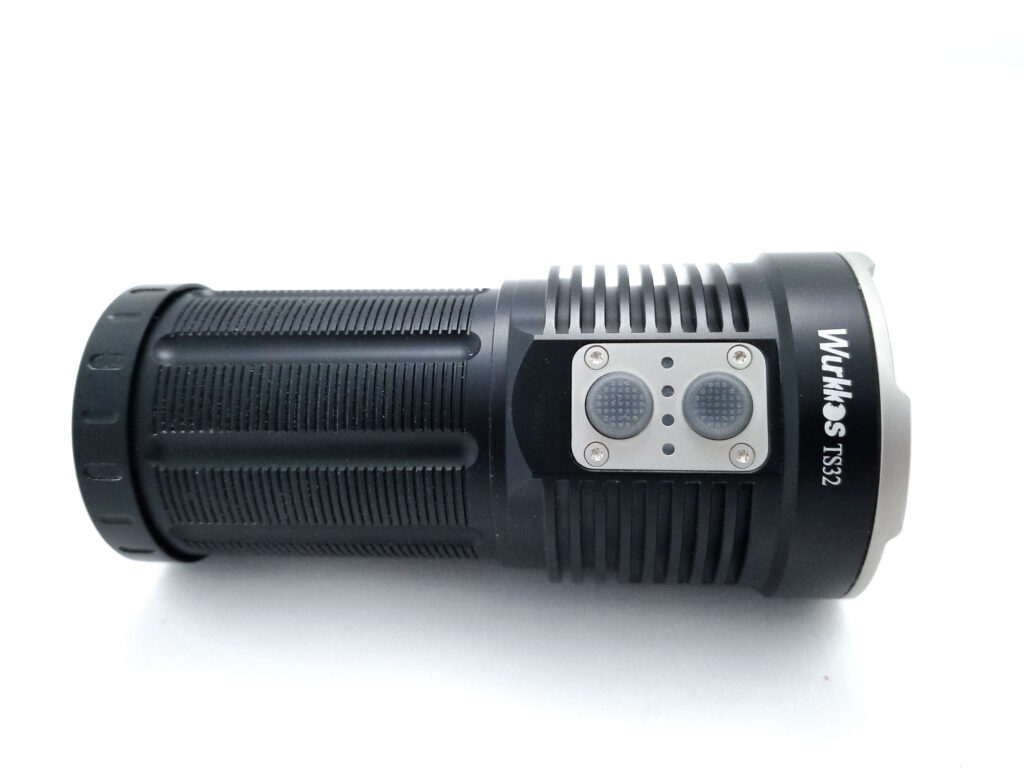
Wurkkos TS32 specifications
| Brand & Model | Wurkkos TS32 |
|---|---|
| Flashlight category | Lumen monster |
| LED | 12*Nichia 519A 1*Luminus SFT-40-W |
| Max. output | 13,000 Lumens |
| Max. beam distance | 637 meters max |
| Max. beam intensity | 85,416 cd spotlight, 38,787 flood |
| Battery config. | 3*21700 |
| Onboard charging | USB-C |
| Modes | 6 |
| Blinkies | Strobe, SOS, Beacon |
| Waterproof | IP68 |
| Review publication date | November 2022 |
Introduction:
If you’d asked me 2 years ago who Wurkkos was, I’d probably have given you a puppy dog look, cocked my left eyebrow and said, “Wurkkos who?” Fast forward 2 years, and despite the funny name, make no mistake, Wurkkos has arisen from a somewhat obscure brand with products made in Sofirn’s shadow, to an absolutely legit flashlight brand.
Starting in mid 2022, Wurkkos started fielding lights that appeal to enthusiasts and regular Joes and Janes. Their recent releases have been particularly good, like the FWAA competitor tiny-triple Wurkkos TS10, FC11 and FC12, high output TS25, and the Anduril 2 sporting TS21 triple. Remarkably, these lights all retail for under $40. What separates Wurkkos from other companies is when brainstorming a new light, they hit the streets and ask the folks who actually use flashlights what they want. With input from Budgetlightforum members, Wurkkos developed and released the TS32, a hybrid flood/throw light with a total of 13 LEDs: 12 for flood, and one for throw, following the pattern of the Lumintop Thor Pro, Fenix LR40R, Nitecore TM20K, and Olight Marauder. They gave it a dual switch UI with smooth and stepped ramping, and all the must-haves for a high output light in 2022 (and beyond): 3x21700s, quick charging with power bank, and of course, the most popular LEDs on the market. All this for under $100 US (with batteries, mind you). Did they pull it off, or is the TS32 another Astrolux MF01X and too good to be true? Let’s take a look.
Package quality.
I don’t expect nice packaging from budget Chinese flashlight manufacturers, and I am totally okay with that. Why waste money on a fancy box that gets binned within a week when you can use it to make a better flashlight? Anyway, the TS32 came in the familiar Wurkkos orange and white box. Nothing fancy with just some specs on the back of the sleeve and a sticker on one end with the LED selection. Inside:
- Wurkkos TS32 flashlight
- 3* 5000 mAh 21700 flat top batteries (loaded in the light)
- Spare o-rings
- USB type A to C charging cable
- Flat-top cell adapter
- Manual
The batteries are optional (c’mon, they’re a cheap add-on, just get them), but otherwise this is a complete kit. Wurkkos even throws in an adapter (like some Convoy lights) so you can use flat top 21700s. This is huge because most 21700s are flat tops (unless you solder blob them). Thanks Wurkkos! There’s an isolator between the batteries and the driver contact designed in a way that leaves zero room for debate as to what you’re supposed to do with it (yep, remove it). The manual is pretty comprehensive…if you can read it as the font is TINY. I almost needed a magnifying glass to read it. Sadly, there’s no USB type C to C cable included, and that’s a drag since they’re cheap and you need one to use the bidirectional charging (power bank) feature. C’mon Wurkkos/Sofirn: USB type C cables are cheap. No excuses.
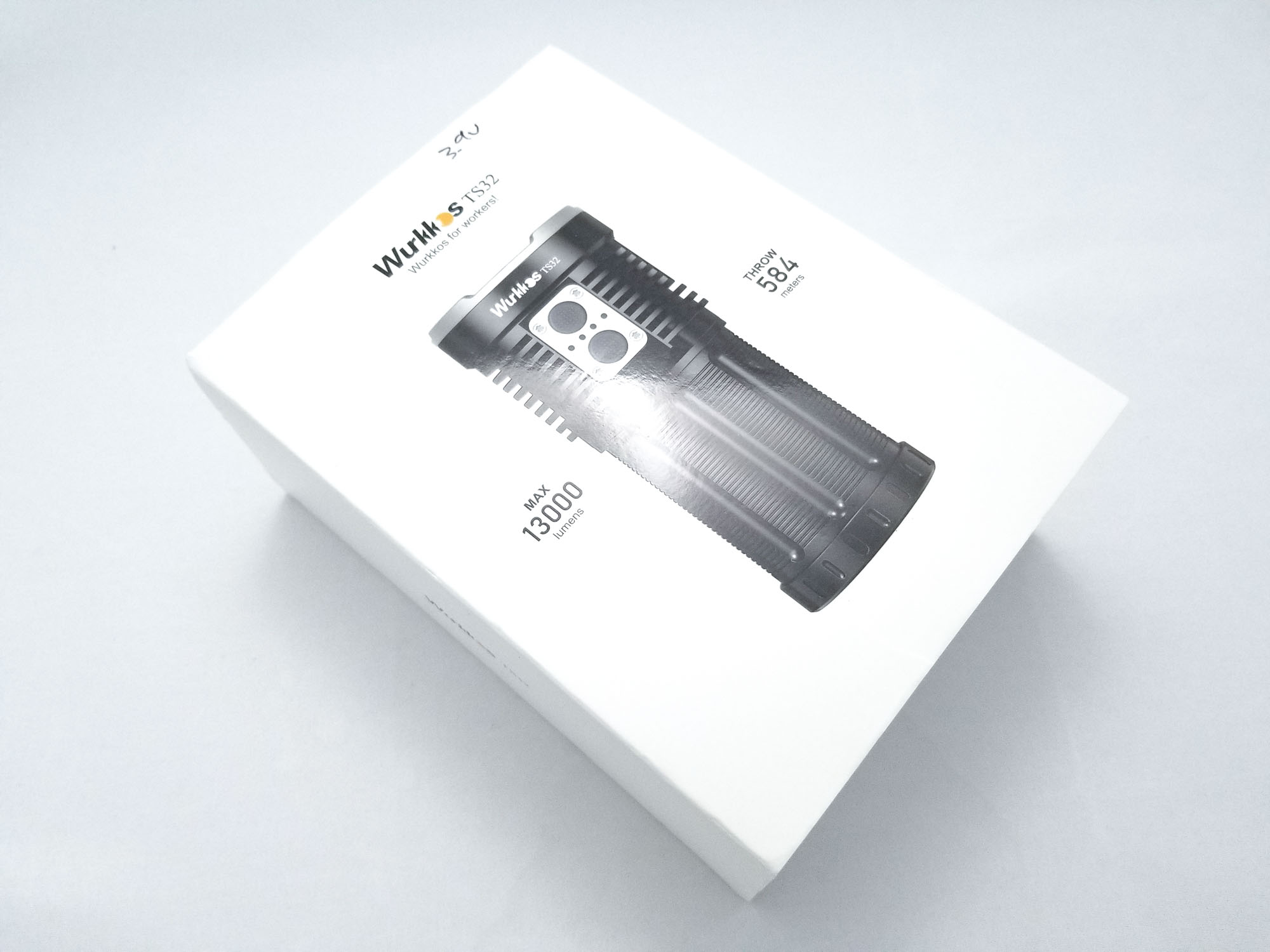
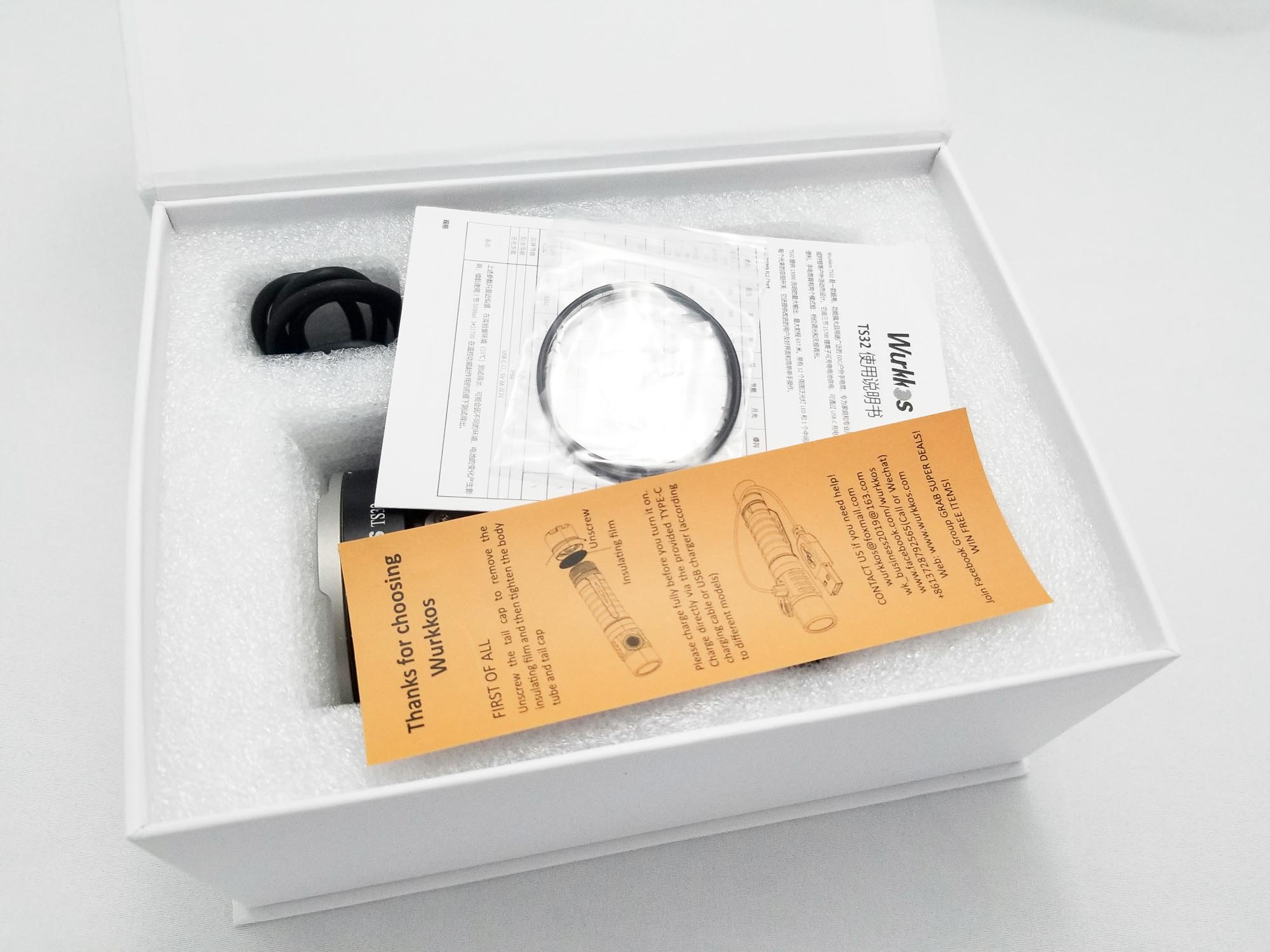
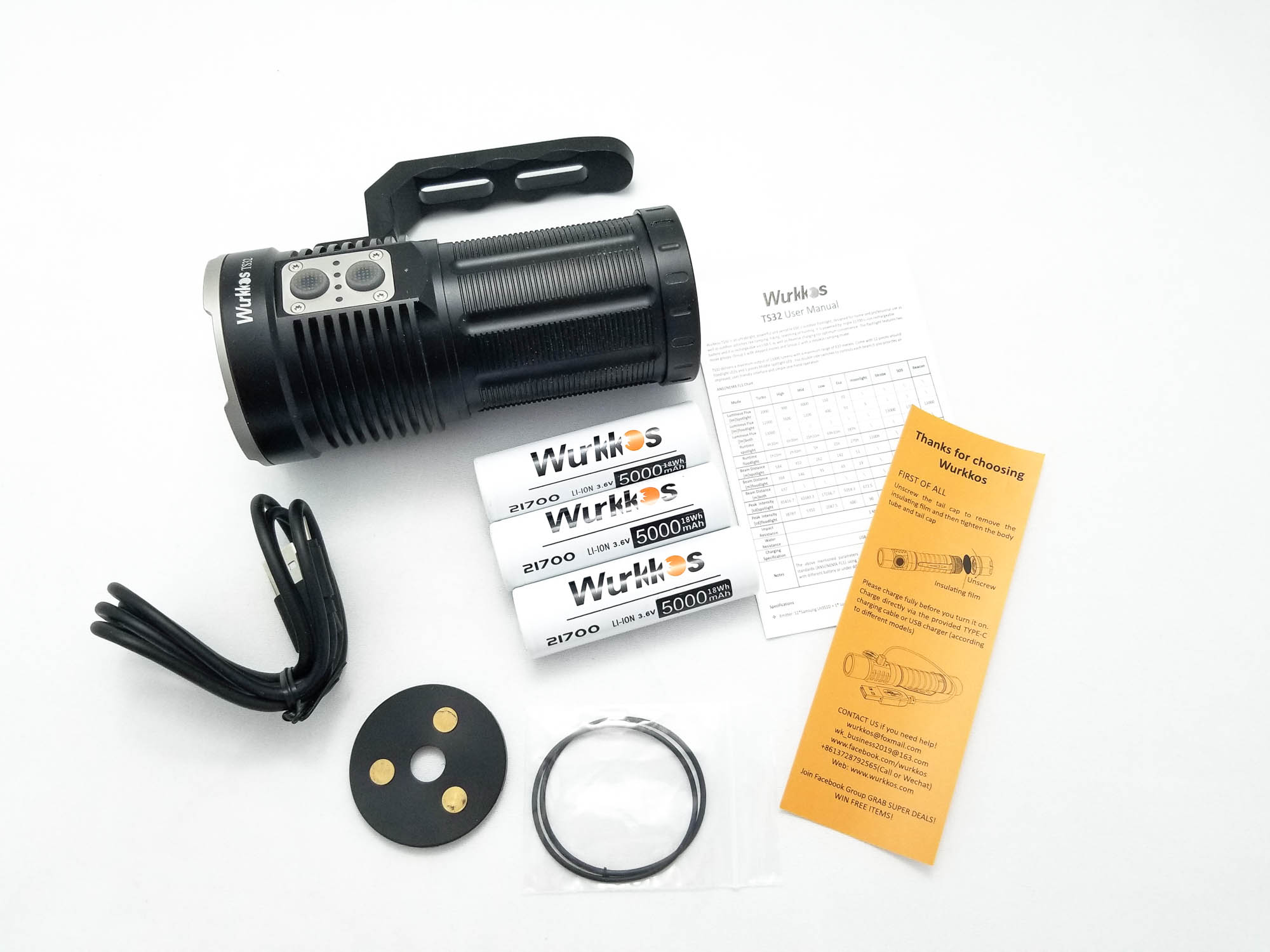
Flashlight in use
The Wurkkos TS32 is a high output multipurpose soda can style light designed for illuminating large areas at shorter to medium distances (about 400 meters). Although it’s designed as such, you can still use it around the house, yard, or campsite. With a diffuser on top, and thanks to the wide, flat tail, it makes an excellent lantern.
For soda can lights, handling is a bit arbitrary, and they’re best handled by, well, a handle. Although I was able to get my big hands around the wide body, and the grippy reeding helped with a firm, solid purchase on it. Thankfully, Wurkkos included a handle (which strangely is optional?), and that’s secured to the body by a ¼-20 UNC Phillips screw. You could thread in a bolt with a swiveling bail to attach a lanyard or strap to, but otherwise there’s no mounting points on the light. The socket also allows the light to be secured to a tripod shoe, and it fits my tripod just fine.
With the handle attached, it’s easy to handle (no pun intended), and it will keep your hands off the hot body during extended high-output runs. I did notice the handle comes loose if it’s not torqued down really tight. A tab with an index slot in the body (or some blue Loctite) may help here. Instead of relying on a single switch for the flood and throw functions, there’s a pair of e-switches at work here. Both are mounted on a bare metal plate secured with 4 screws. One controls the throw function, and the other controls the flood function. I really like this setup, and it’s sort of like a headlamp, and easy to use. In between the two switches are 4 blue LED indicators that show battery and charge/discharge state for the charging and power bank functions. I like the switches. They have grippy rubber boots, and although the clicks are somewhat muted clicks, the feedback is decent. The LED indicators aren’t lit on standby, but do stay illuminated after switching it off for about 10 seconds. With the handle on, it won’t roll around, but handle-less, it will wander off on an incline.
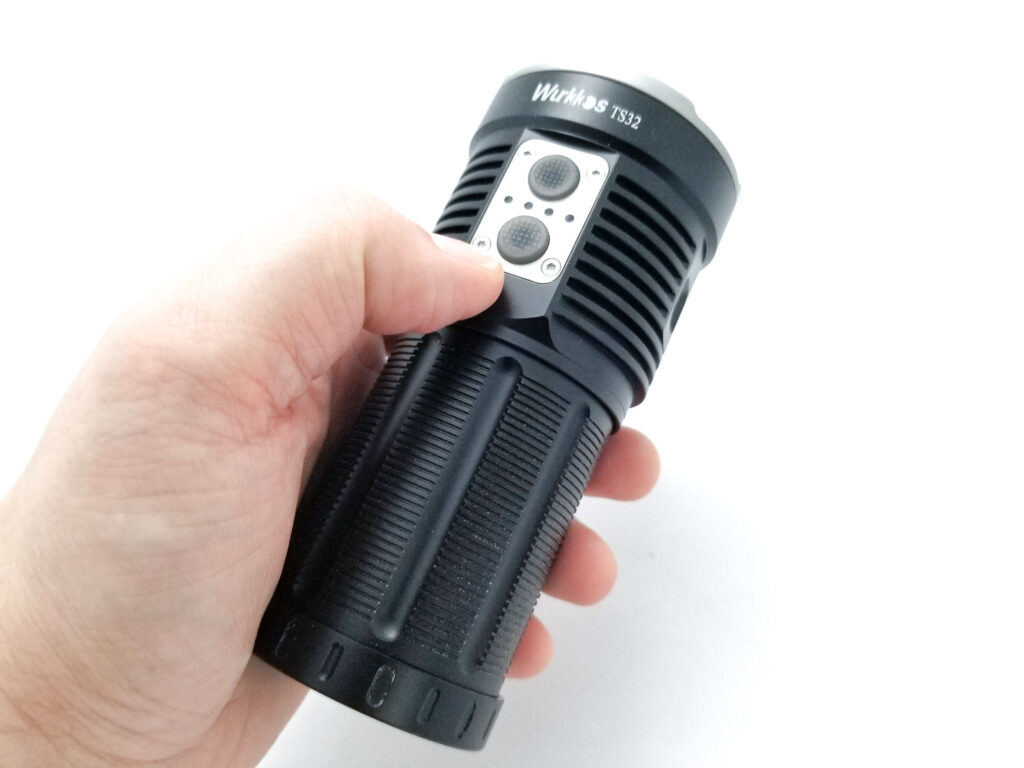
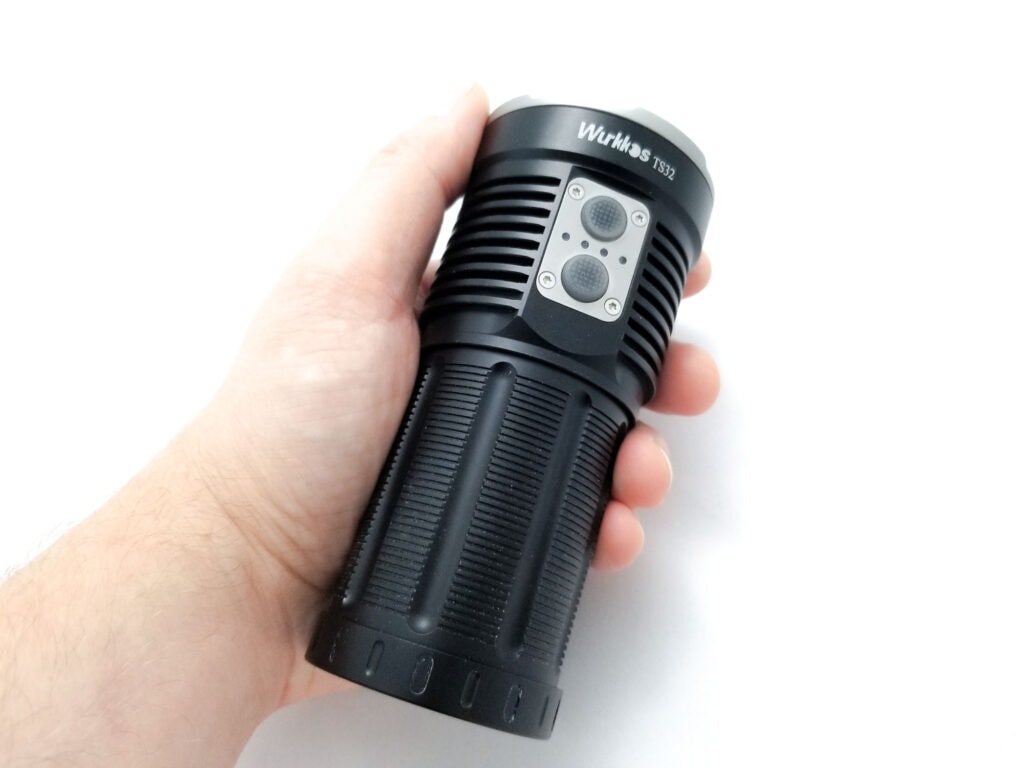
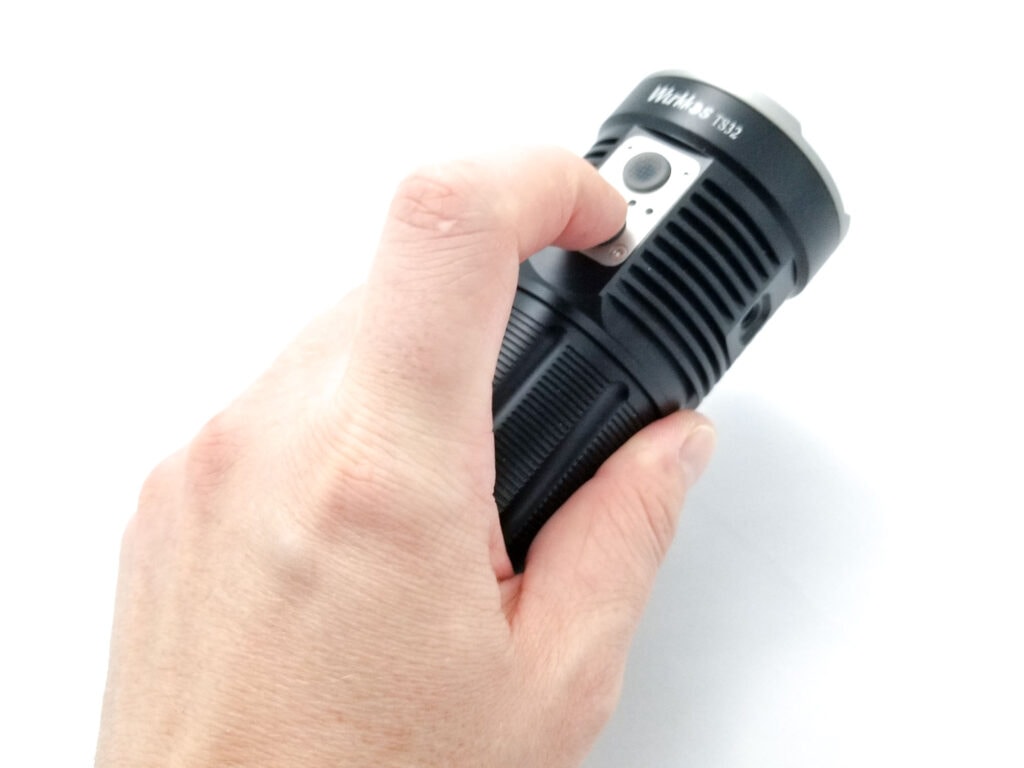
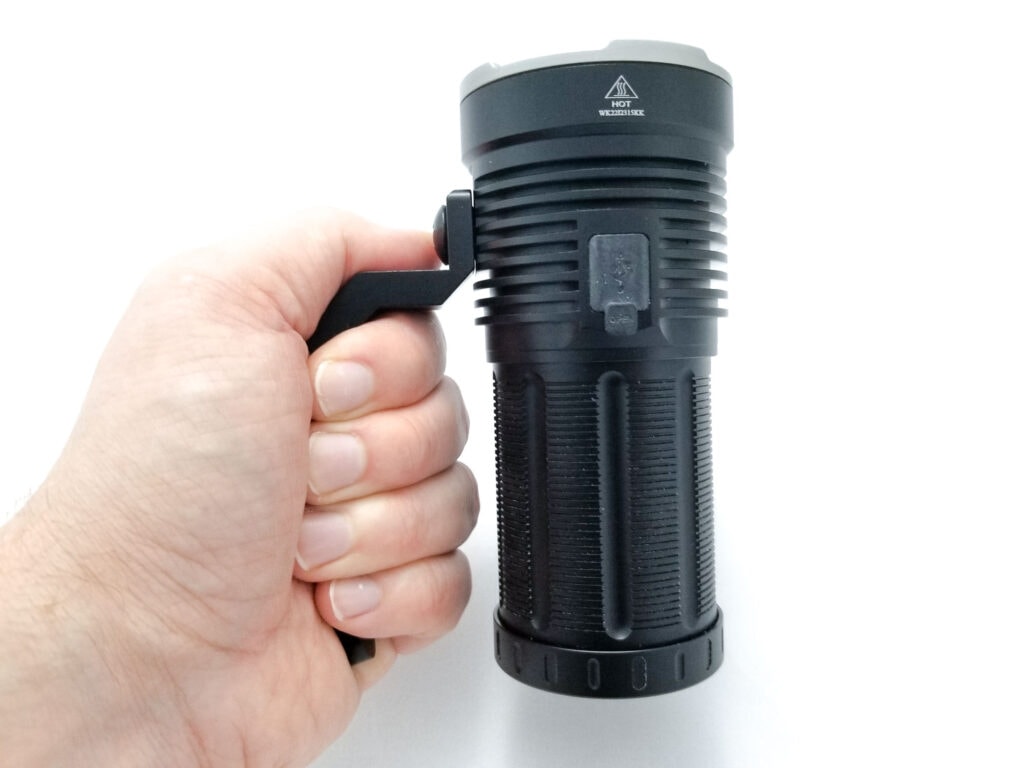
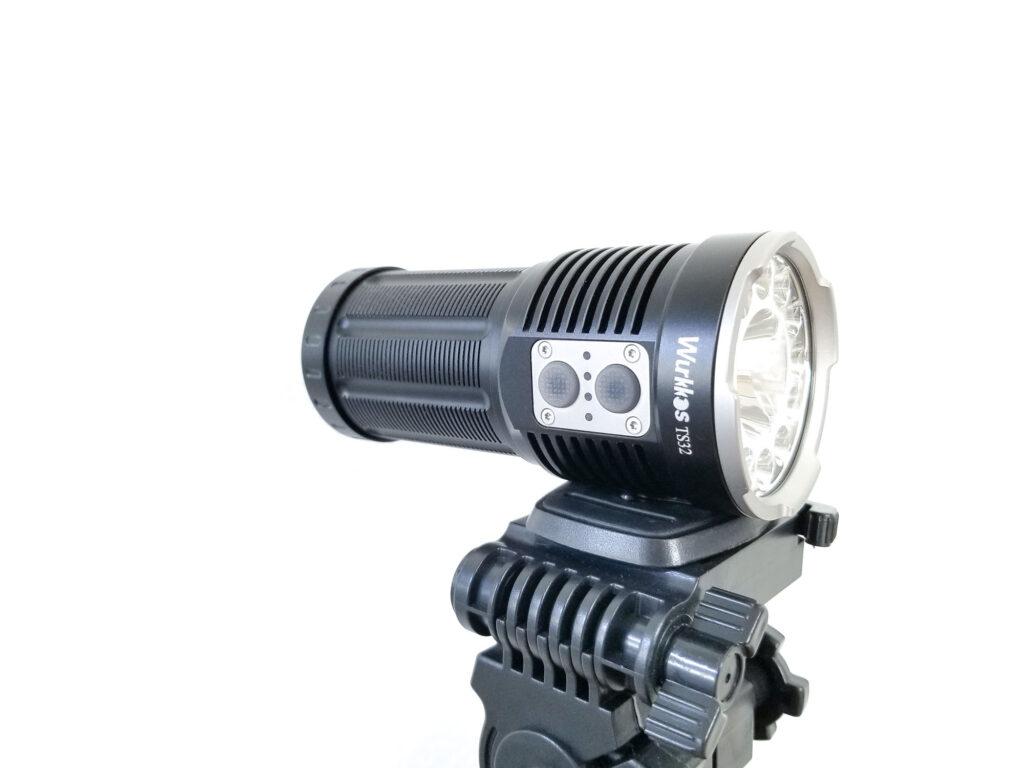
Build Quality, and Warranty
We should all know by now that Wurkkos is just a reseller, not a manufacturer and farms their production out to Sofirn to manufacture the TS32 for them. Wurkkos designs it, Sofirn builds it. We know Sofirn makes a solid budget light, and the TS32 is indeed a budget light, coming in at under $110 with batteries, which is a freaking steal for a light like this when the Fenix LR40R and Nitecore TM20K are twice that much. The real question is has Sofirn passed its DNA down to the TS32? In short, yes, and it shares at least one component with the Sofirn/Astrolux EC06 (the tailspring PCB is clearly marked ‘EC06.’
It’s milled from 6061 aircraft aluminum and the machining is totally acceptable with no major blemishes or blatant tool marks. There were some dings on the handle that were covered by the anodizing, but they’re hard to notice. The anodizing is type III HA, and it’s a semi-gloss finish typical of Sofirn products I’ve handled. Not too bad, but not my favorite, and it is well done with no discernible blemishes or coverage issues.
Although the fit-up on the external parts is copacetic, there’s a glaring issue with the reflector fit up. Several of the outer LEDs are not properly aligned in their reflectors. Although it doesn’t seem to affect the performance, it’s still a pretty bad quality control failure on Sofirn’s part. There are other reports of quality snafus from other buyers as well, with missing thermal paste or the flood LED MCPCB not being properly secured to the LED shelf, to others experiencing burned LEDs. I didn’t experience any of those, but misaligned LEDs are a drag.
Unscrewing the battery tube reveals some nice threads. They’re fully anodized and really smooth and well lubed. The only springs are at the bottom of the tube for the negative contacts, and they’re bypassed from the factory. I don’t know if they’re high-current copper alloy though. I tried manhandling it to unscrew the bezel, but it’s probably glued. A bummer since the misaligned LEDs drive me bonkers. The driver is held on with two T6 Torx screws, and removing them did allow some movement from the driver, but either the LED wires are really short, or it’s jammed in the driver cavity and I gave up trying to liberate it.
It appears to be a stacked driver with a daughterboard for the switches and charging input. You can also remove the metal plate holding on the switch boots by unscrewing the four phillips screws. The charge port cover is lifted from Sofirn’s SP-series lights and it’s a good one, creating a nice tight seal that made a pffttt noise when opening it after replacing the batteries. It’s designed so as not to get snagged on things like the older style Sofirn ones. Wurkkos says it’s good for IP68, but caveat emptor on that one.

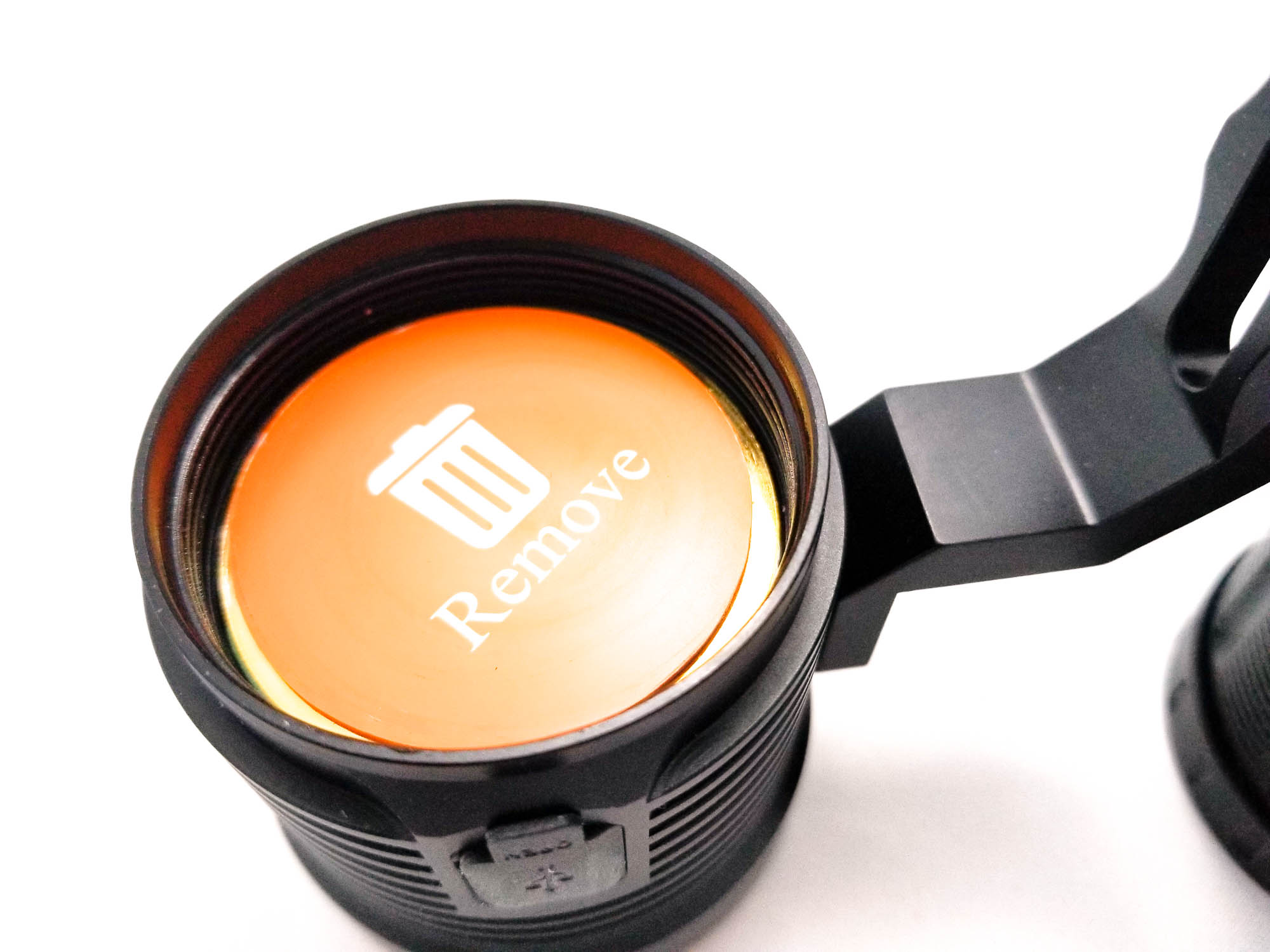
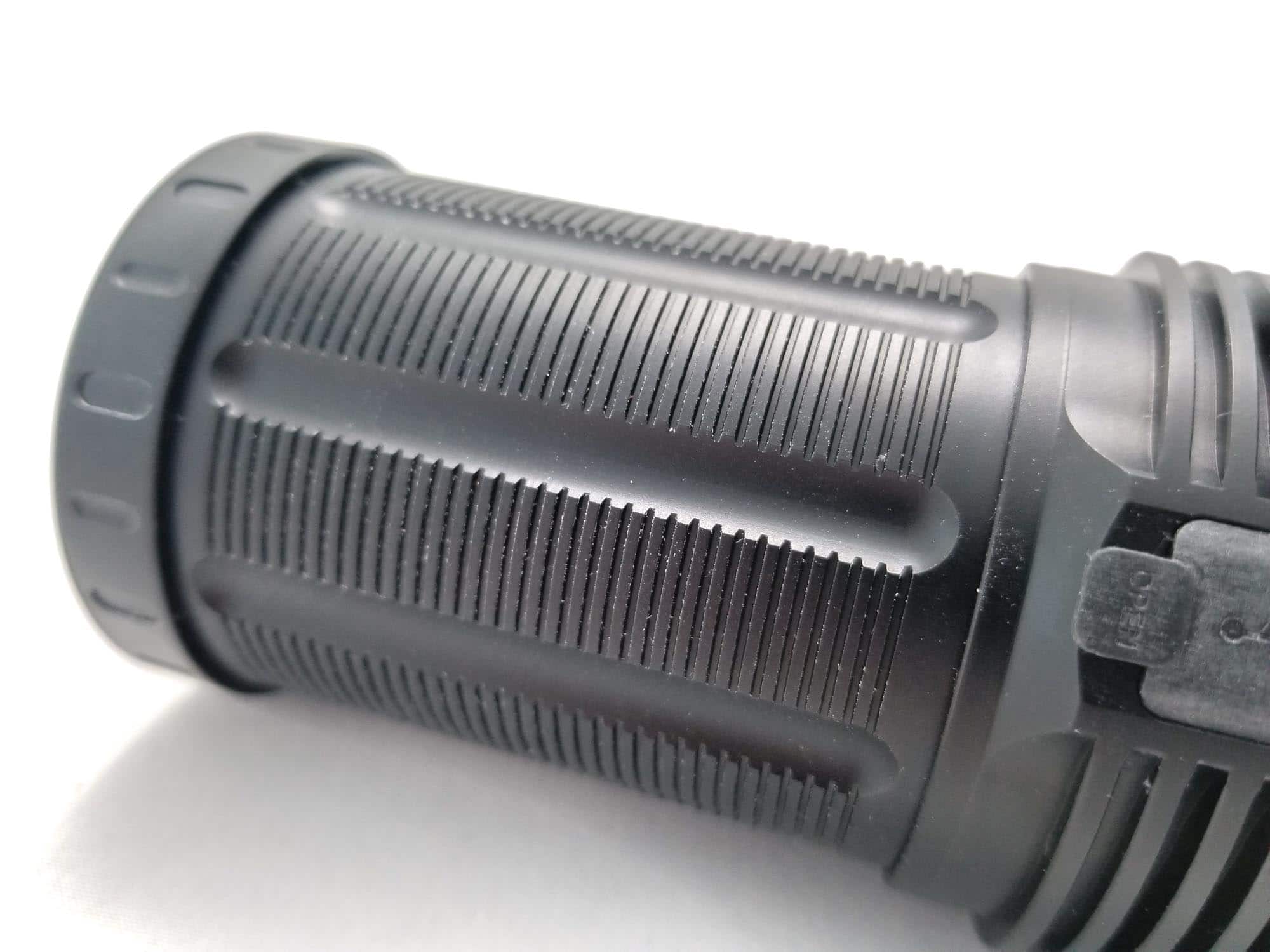
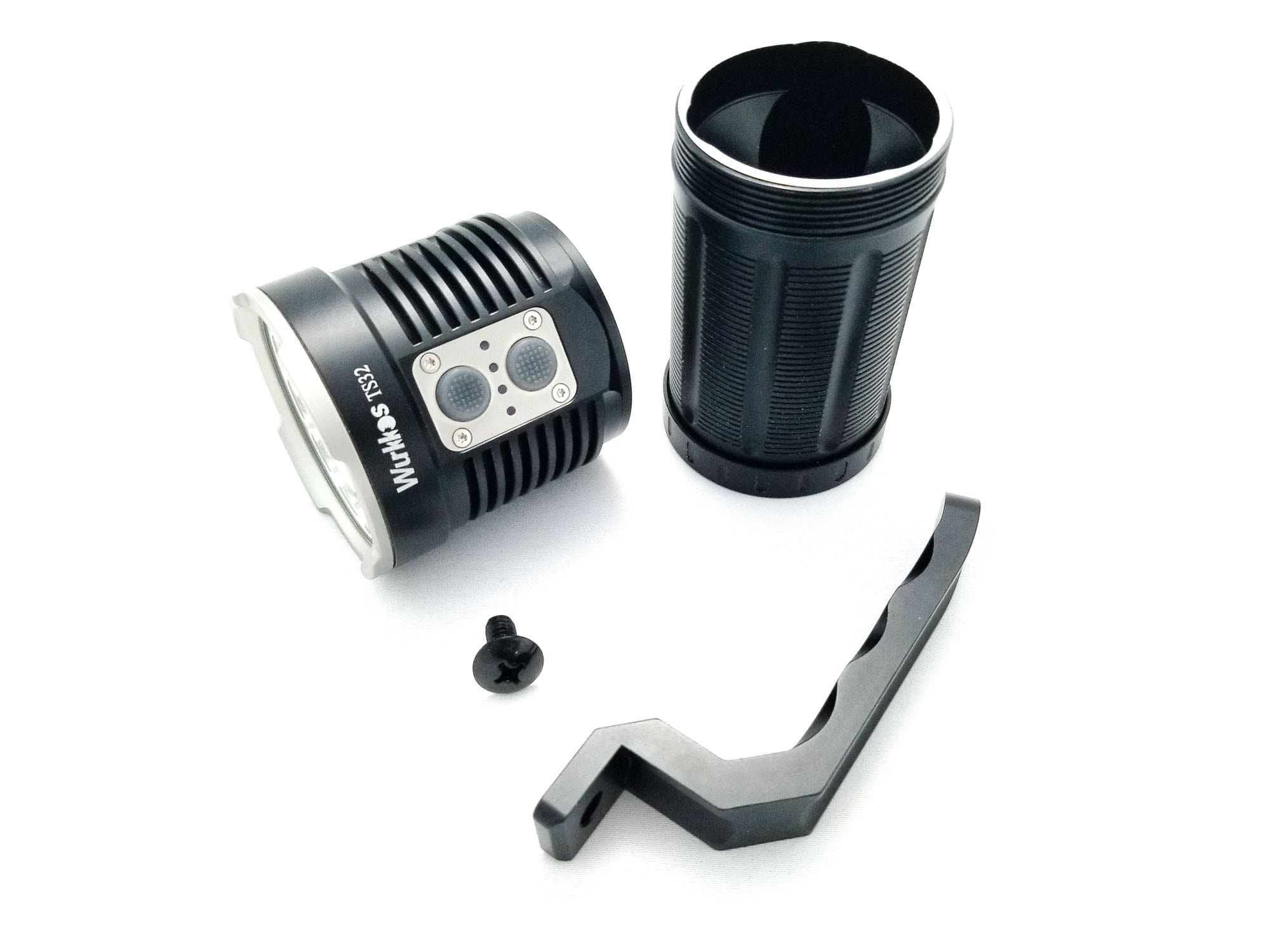
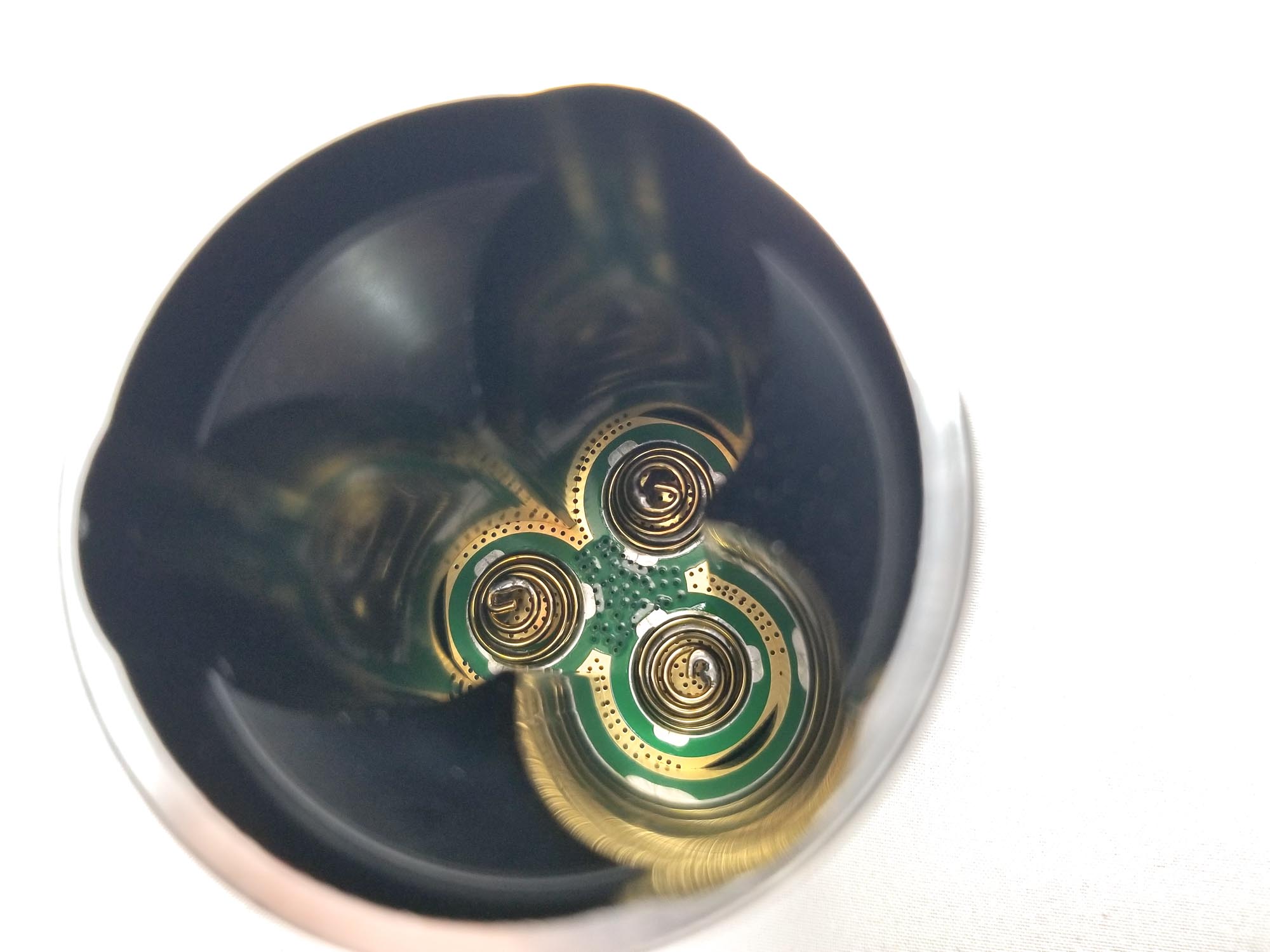
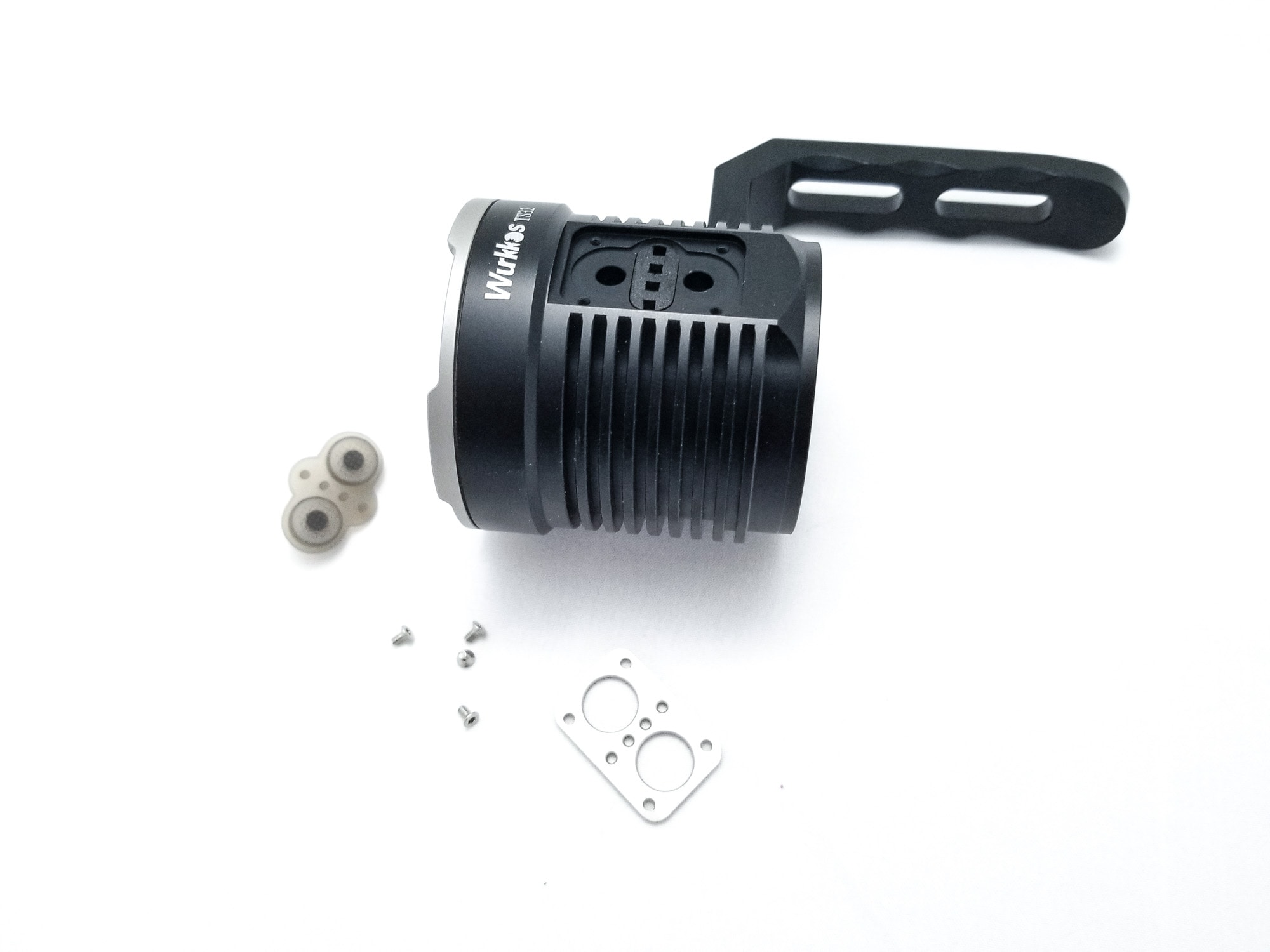
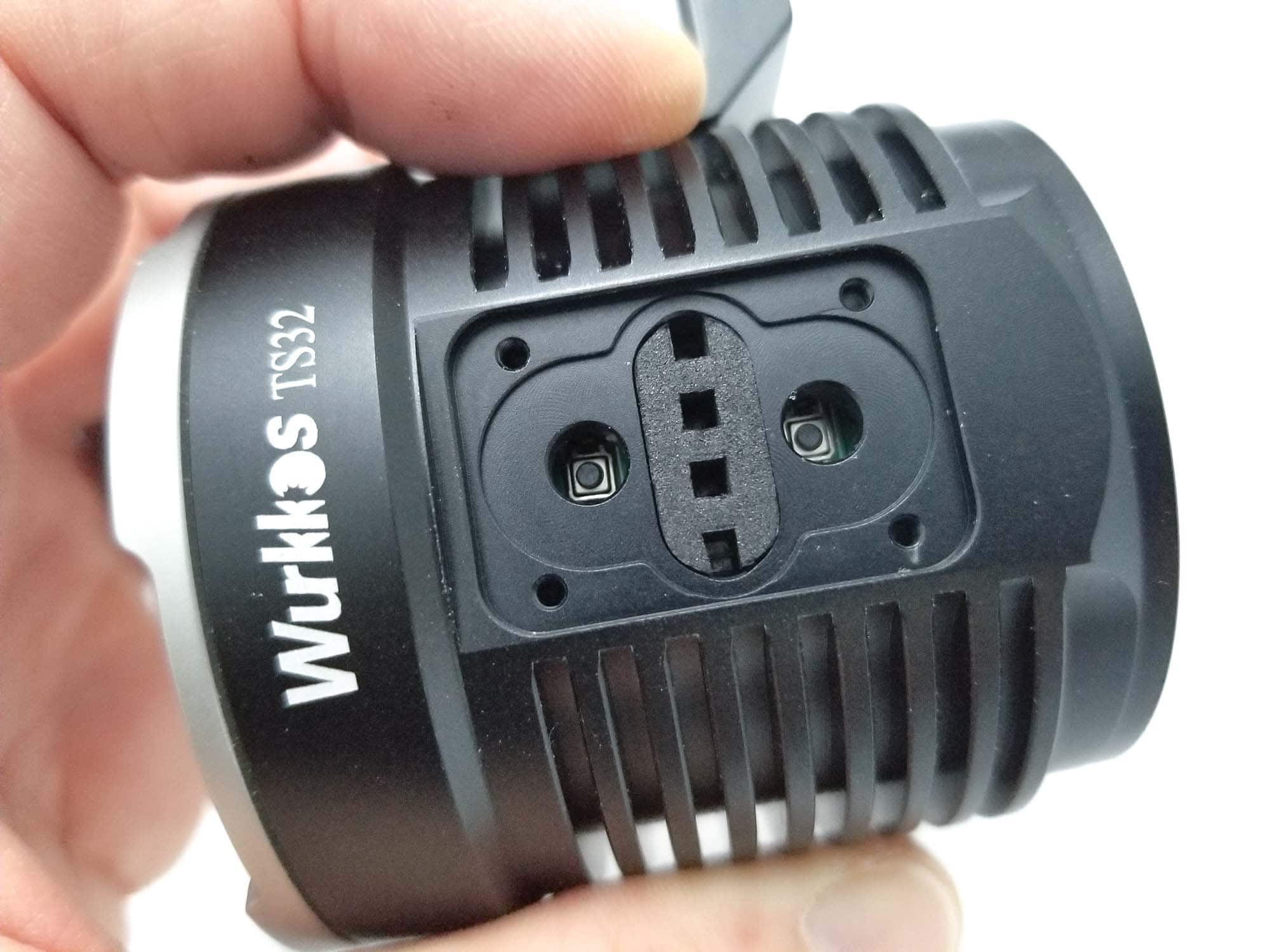
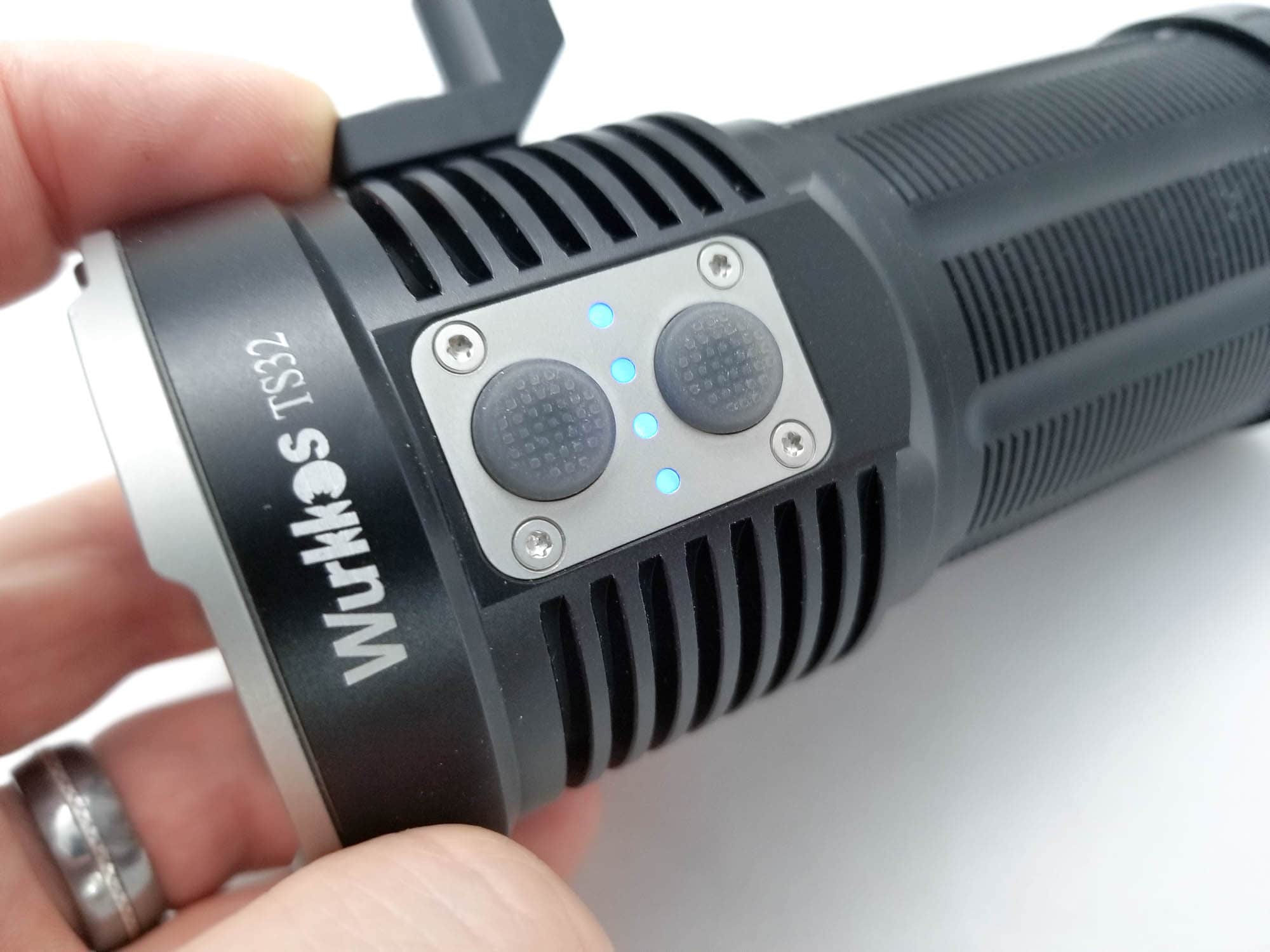
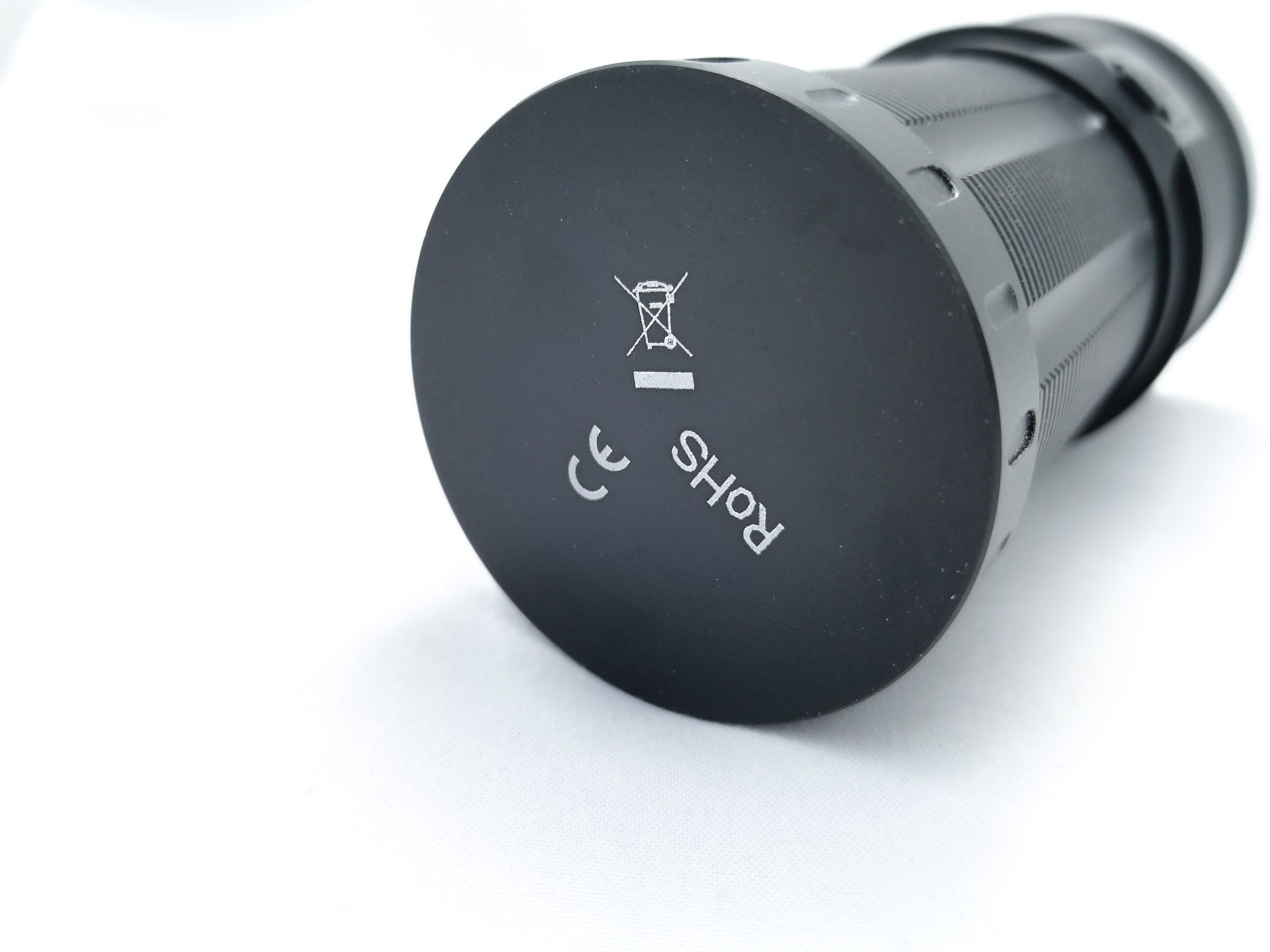
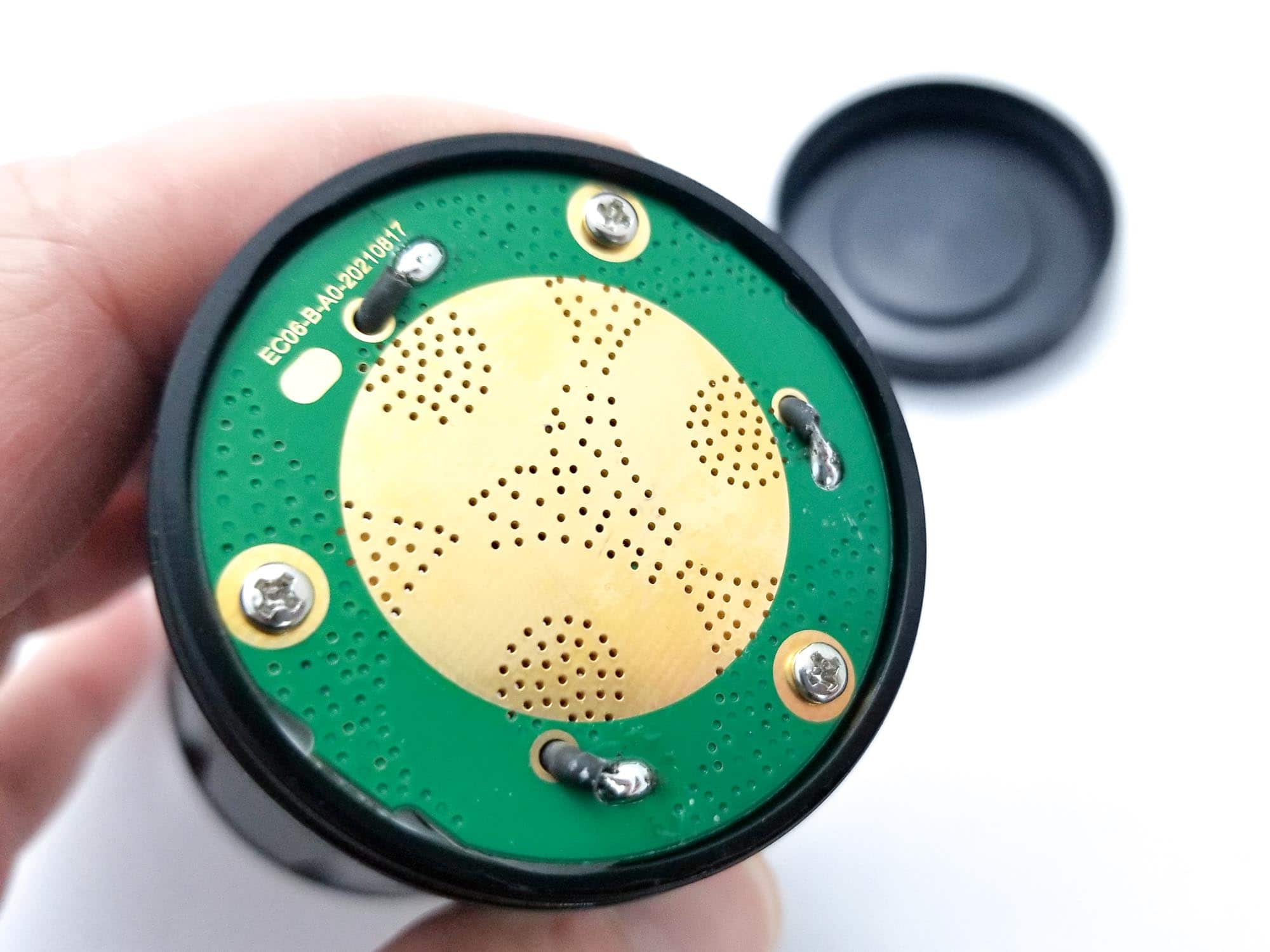
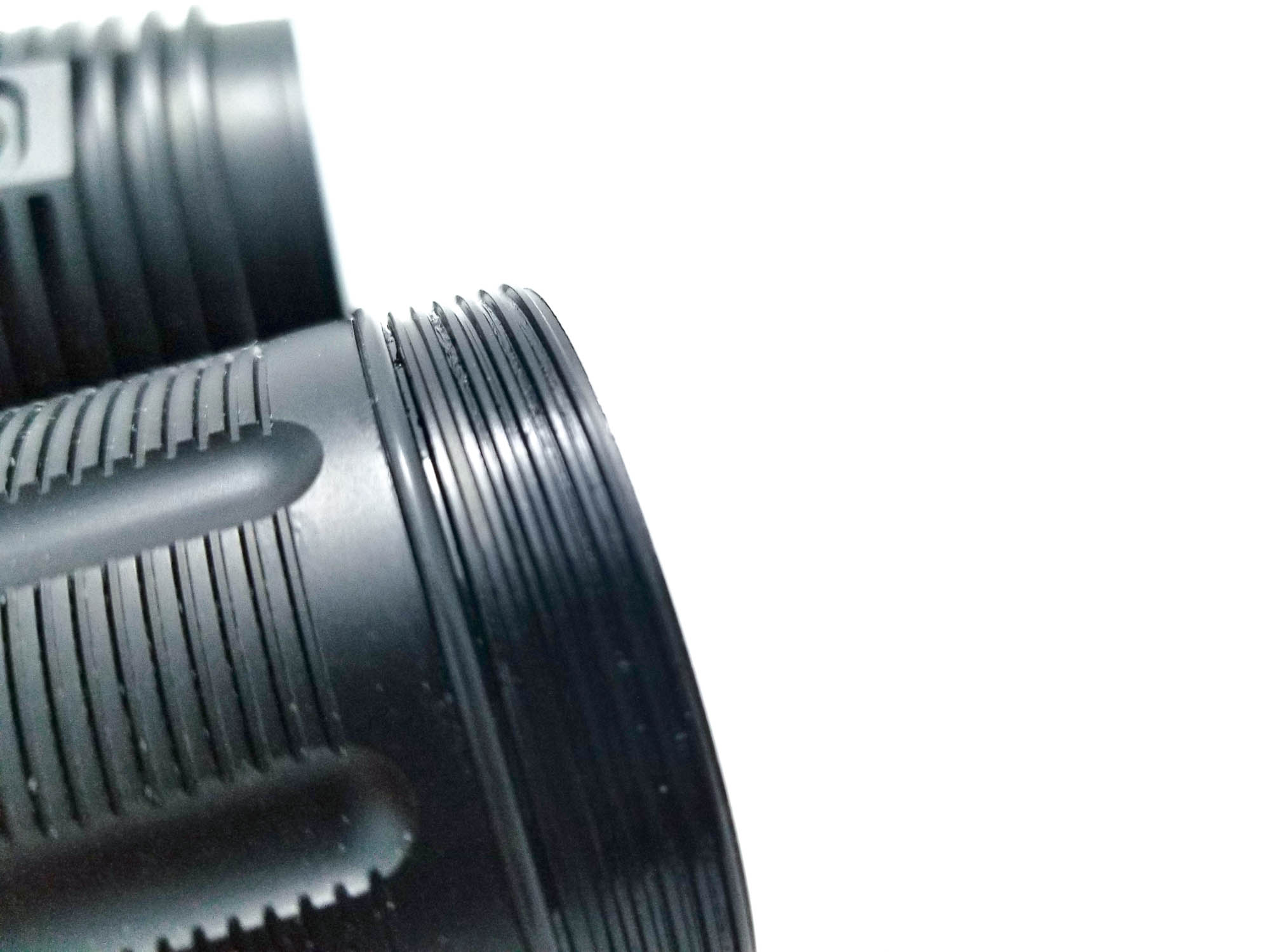
LED, Lens, Bezel, Beam, and Reflector
The TS32 uses a total of 13 LEDs: 12 LEDs are arranged in a ring surrounding a deep center reflector for the flood/throw functionality. The outer LEDs provide the flood; the center provides the throw. The outer LEDs have gone through a couple of revisions, and the first release of the TS32 featured Cree XP-L2 LEDs for the flood function. The XP-L2s, while great for raw output and good efficiency, aren’t known for a good beam, and everyone and their uncle seems to want high CRI and rosy tints these days.
It was only a matter of time before Wurkkos heeded the cries and shouts of “high CRI, high CRI!” from the folks brandishing clubs and torches, adding high CRI Samsung LH351Ds as an option. Although the LH351D is a great LED, it’s not the bees-knees anymore, so Wurkkos added the 5000K Nichia 519A. Designated the NVSW519A, this is a pretty new LED. It’s a 3535 size, CSP flip-chip LED (no external bond wires) with a homogeneous LES. The die is slightly smaller than the Samsung LH351D for a bit more throw, and is available in 70 CRI as well as R8000 and R9080 variants. Unlike the 219 series, it doesn’t sacrifice much in output and can be driven much harder while still producing very high CRI and excellent color rendering.
The center LED is the Luminus SFT-40-W. It’s a domeless, 5050 size LED built as a replacement for the domed SST40 (although you can still get the SST40 in 5000K). It’s capable of very high output and excellent cd/mm2 for high intensity, which is good for throw. It’s only available in cool white, generally coming in around 6000K to 6500K and low CRI. The flood LEDs are situated in a ring surrounding the larger center reflector. Each has its own roughly 12 mm wide SMO reflector, while the center LED has a 40 mm wide, deep SMO reflector. Although some of the flood LEDs are poorly aligned in their reflectors, the center LED is nicely centered and well focused. Everything’s topped off by a AR-coated mineral glass lens and a nice crenelated stainless bead-blasted bezel, which will offer good protection for the lens.
The tint from those 519As doesn’t disappoint. The Opple Lightmaster Pro has the 519As coming in at 5217K at RA 97.9 with the light positioned 2 meters from the sensor in High mode. The duv is 0.0035, which is pretty close to the BBL and nice and neutral. On High, the Luminus throw LED is coming in at 6176K and RA 65.9. Duv 0.0062. The flood beam is as beautiful as it is effective, with a huge dim hotspot and a wall of beautiful, rosy neutral high CRI light. The throw beam is a typical thrower, with a tight hotspot and very bright (abundant!) spill. The beams are pretty clean and uniform, so the misaligned LEDs don’t seem to affect it much that I can see. With both spot and flood activated, the beam is very useful and has great flood and distance.
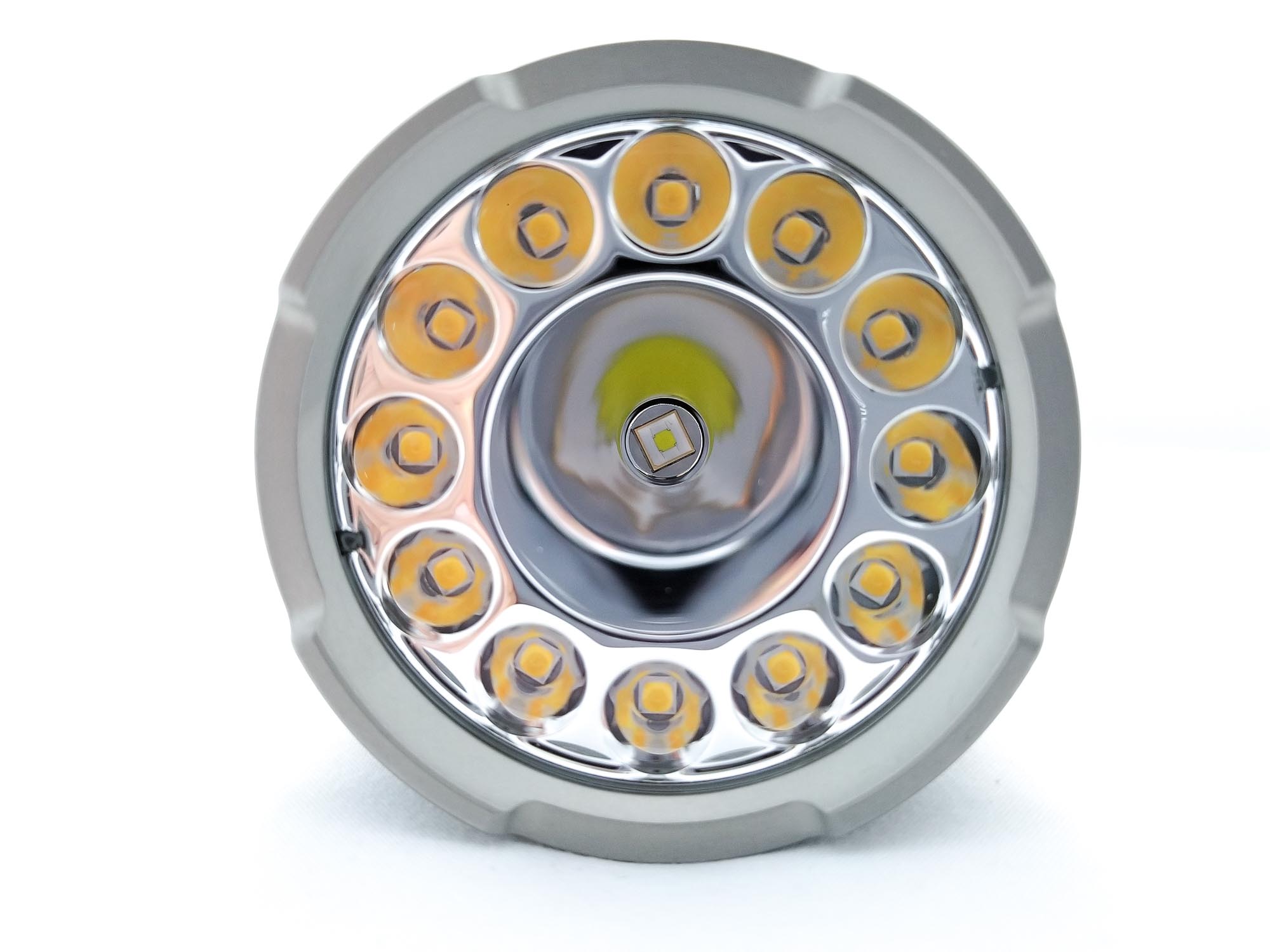
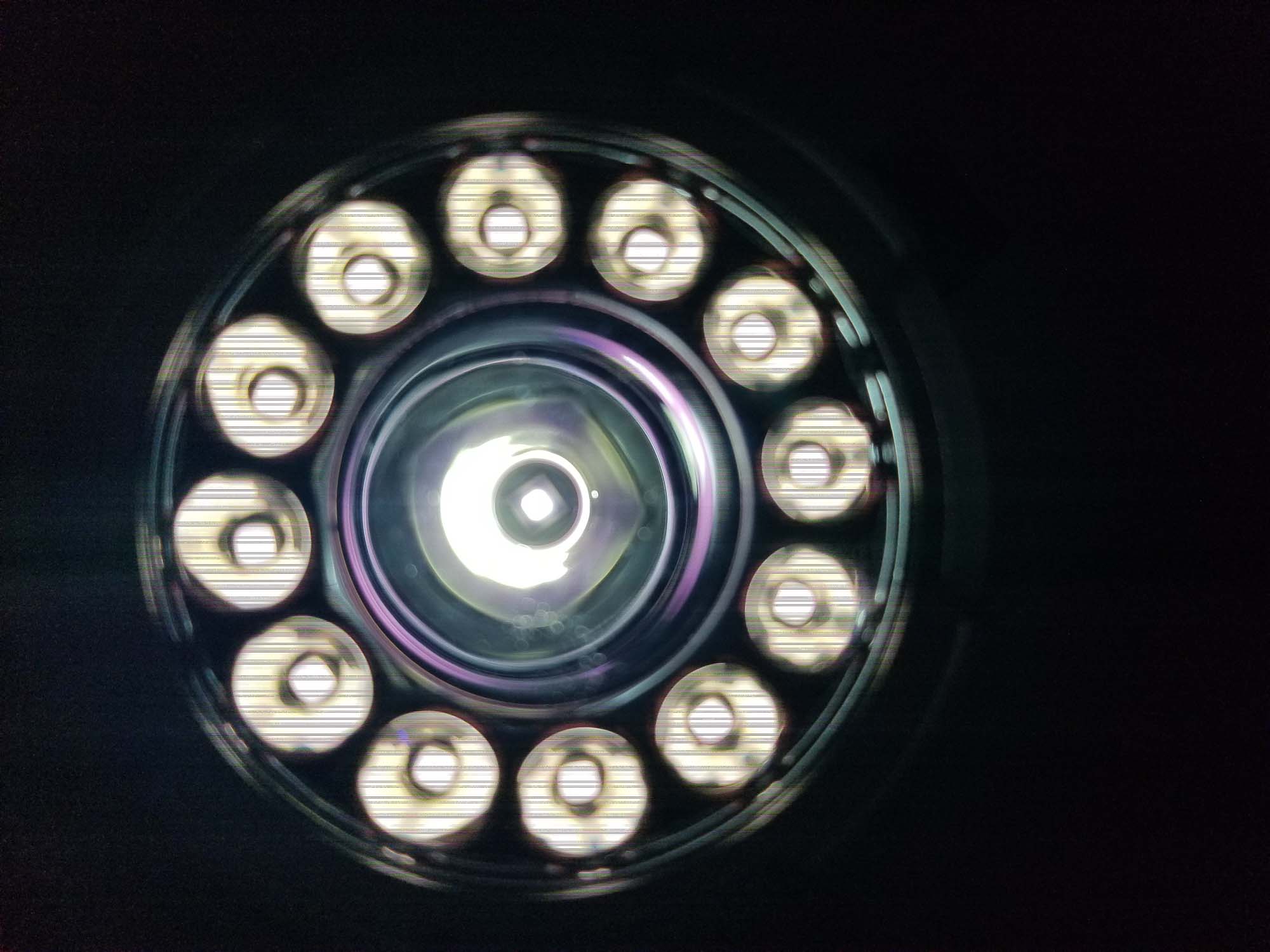
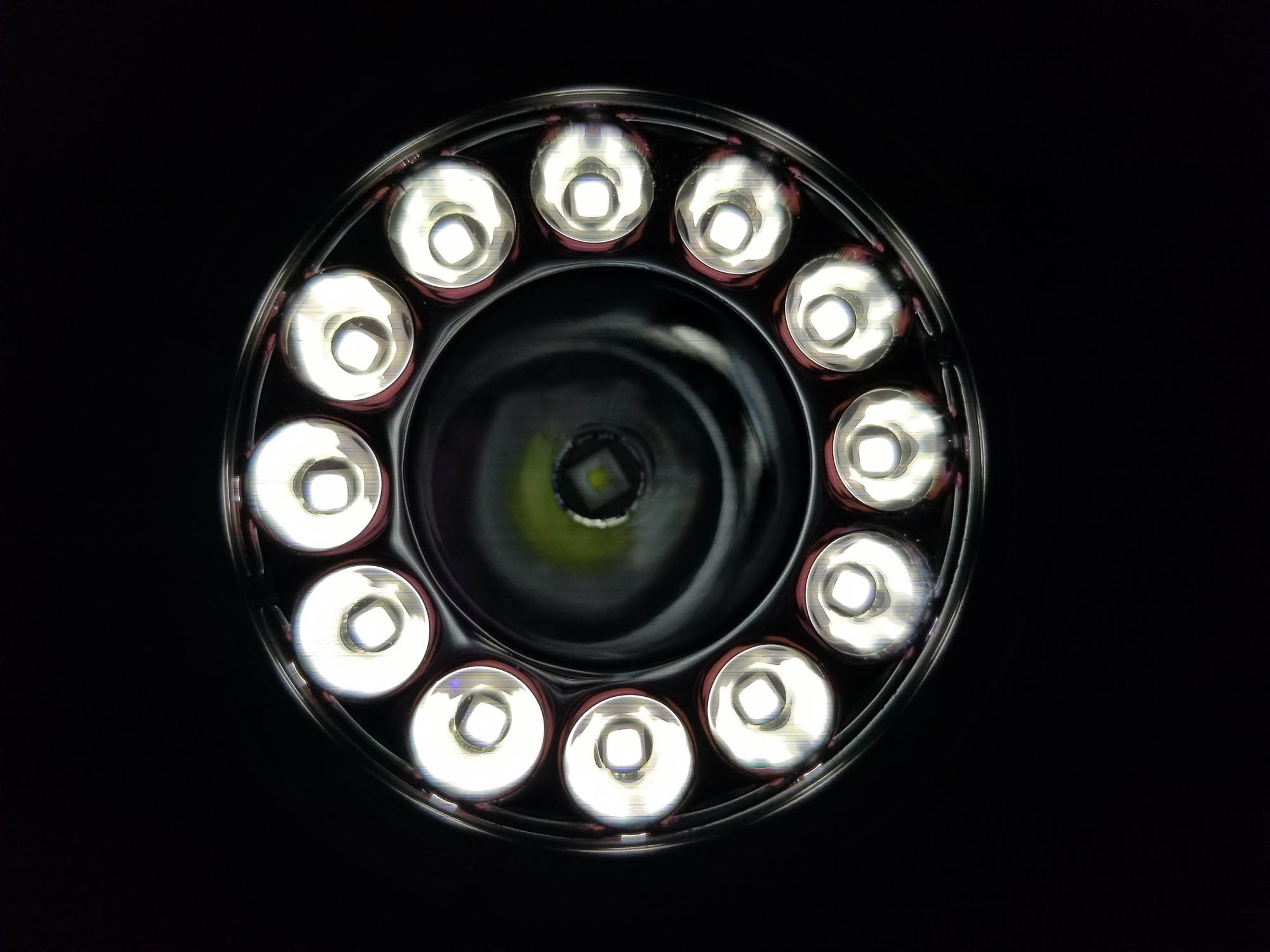
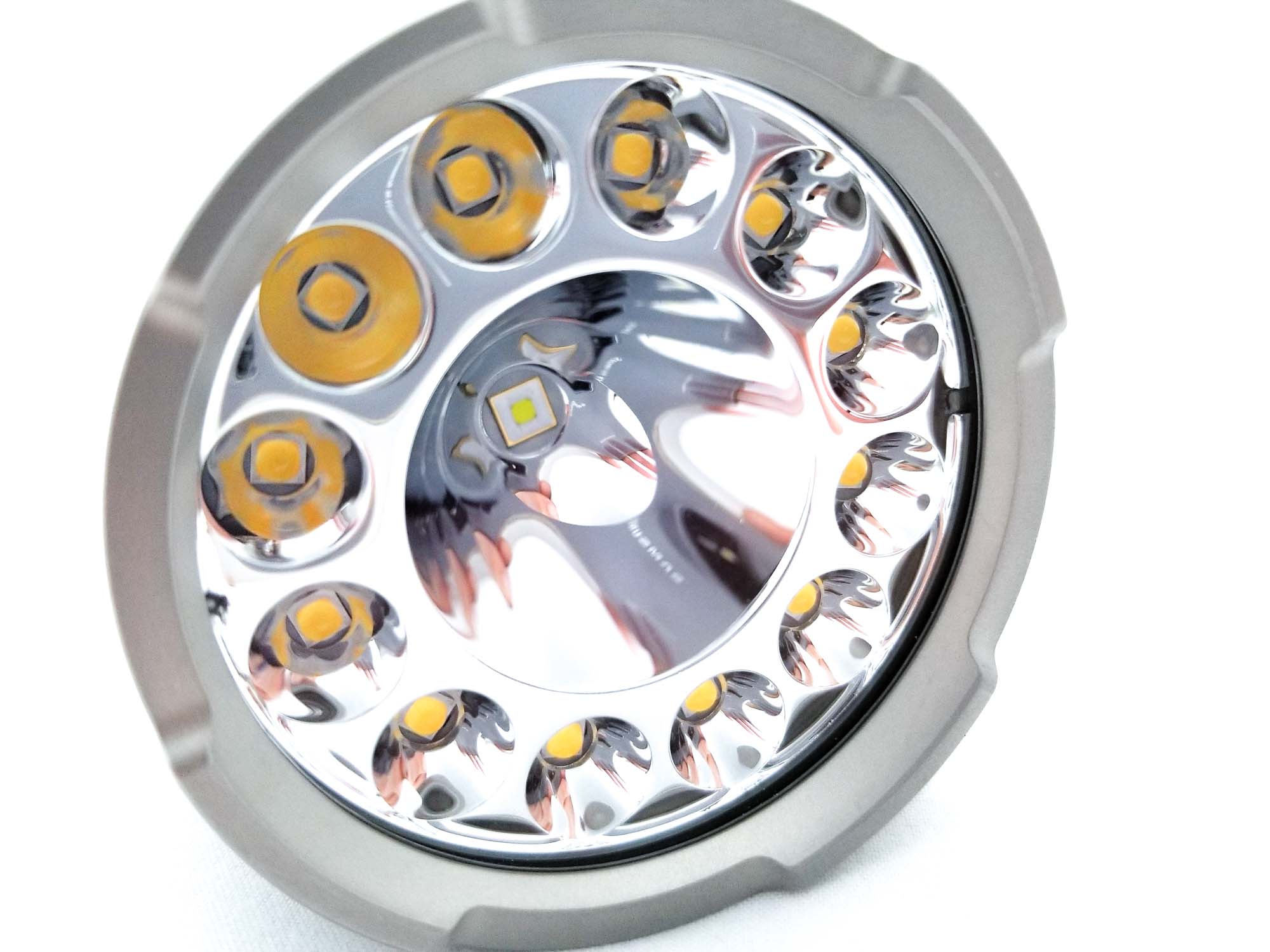
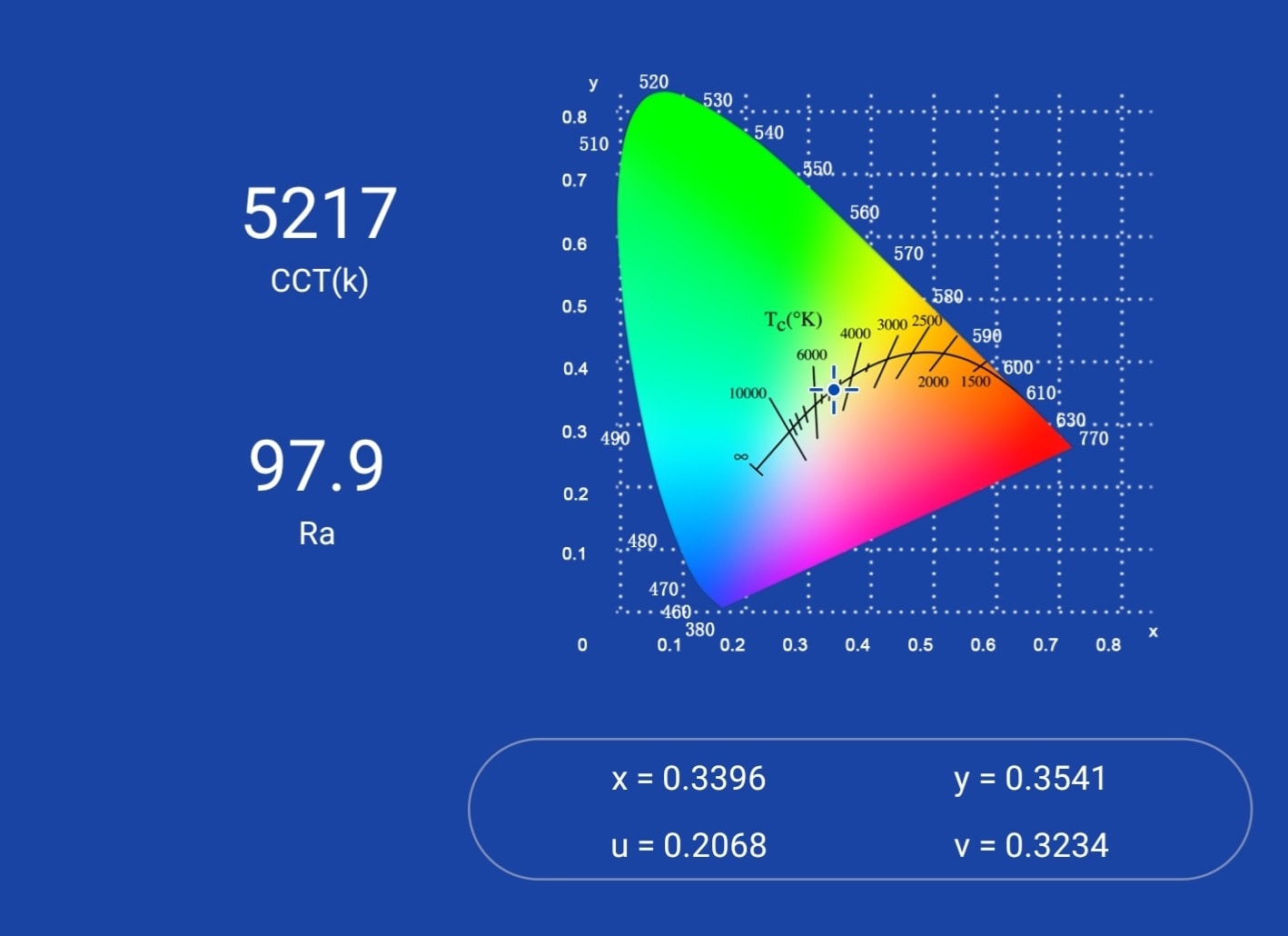
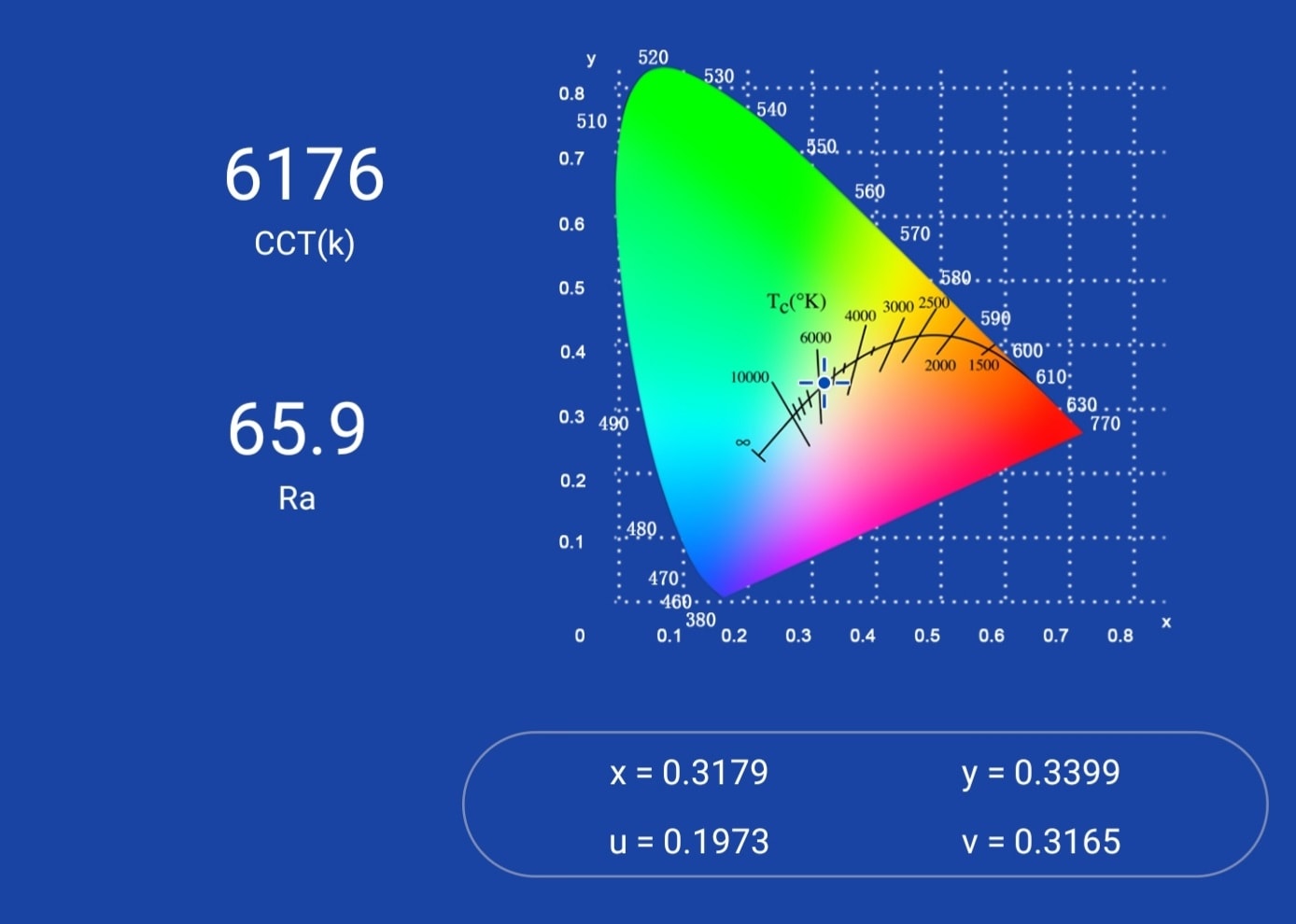
Dimensions and size comparison
Dimensions:
| Dimension | Millimeters | Inches |
|---|---|---|
| Length | 132 | 5.2 |
| Head diameter | 62 | 2.5 |
| Body diameter | 62 | 2.5 |
Weight:
| Weight | Grams | Oz. |
|---|---|---|
| Without battery (+handle): | 475 | 16.7 |
| With 3 Wurkkos 5000 mAh batteries (+handle) | 684 | 24.1 |
Flashlight size comparison with its competition
I compared the TS32 to some other high-output soda can lights.
Group 1 left to right: Wurkkos TS32, Haikelite HT90
Group 2 left to right: Wurkkos TS32, oldie (but goodie) Skyray King, Thorfire C8
Group 3 left to right: Wurkkos TS32, Thrunite TN50, Sofirn SP36 Pro
Group 4 reflectors left to right: Amutorch DM80, Wurkkos TS32, Nightwatch NS59v1, Sofirn SP36 Pro
Group 5: Wurkkos TS32, Fenix LR80R
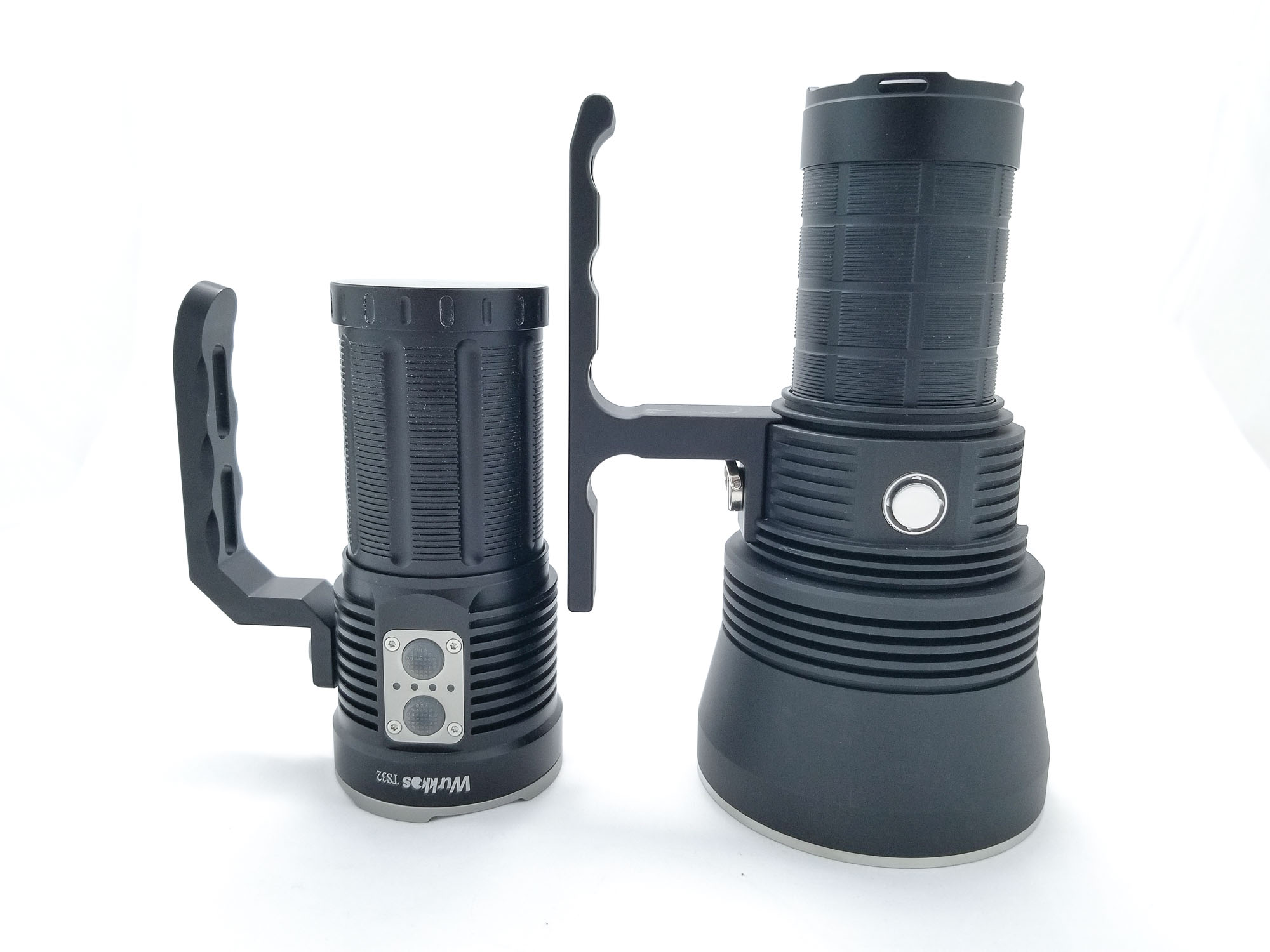
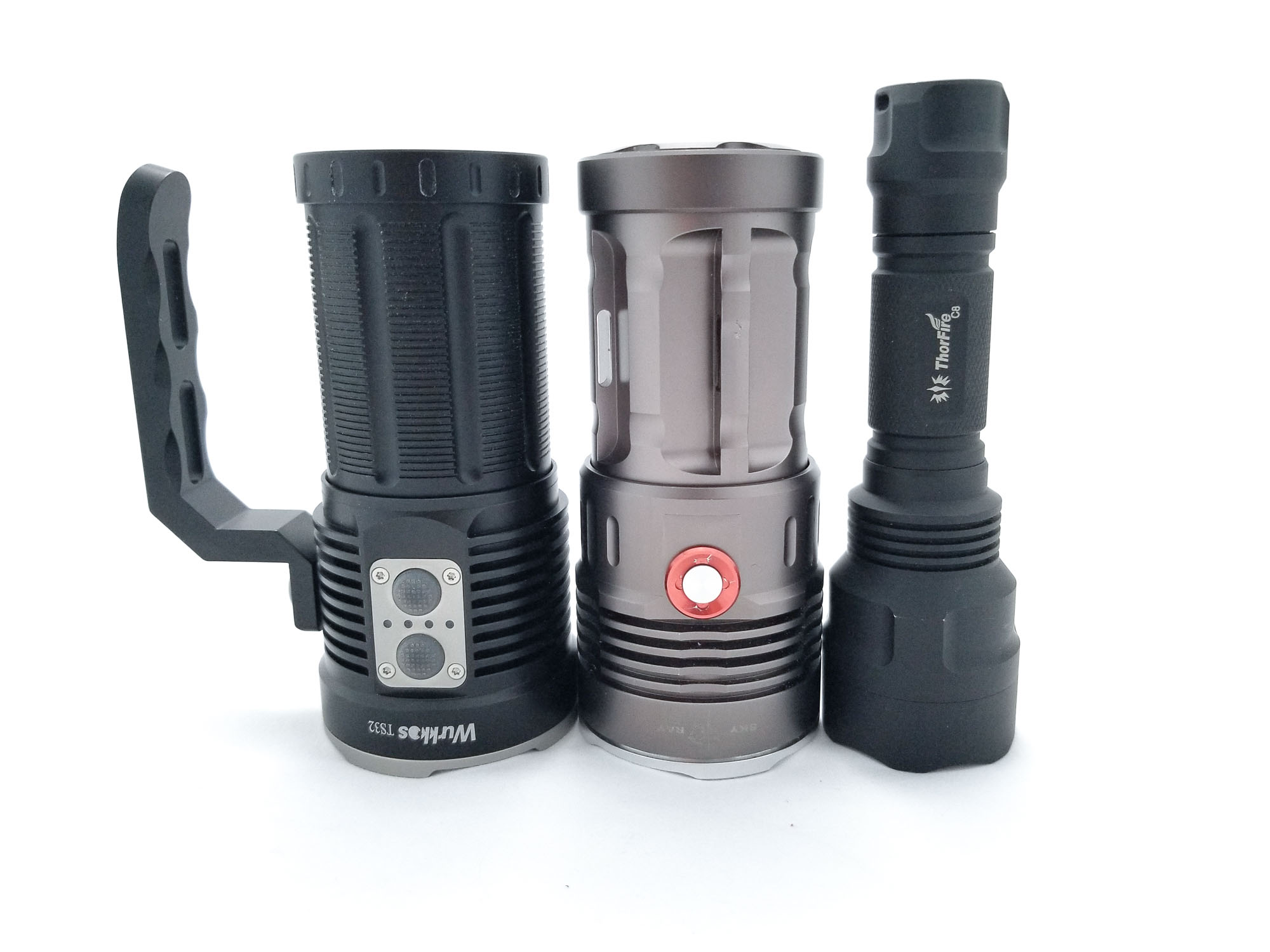

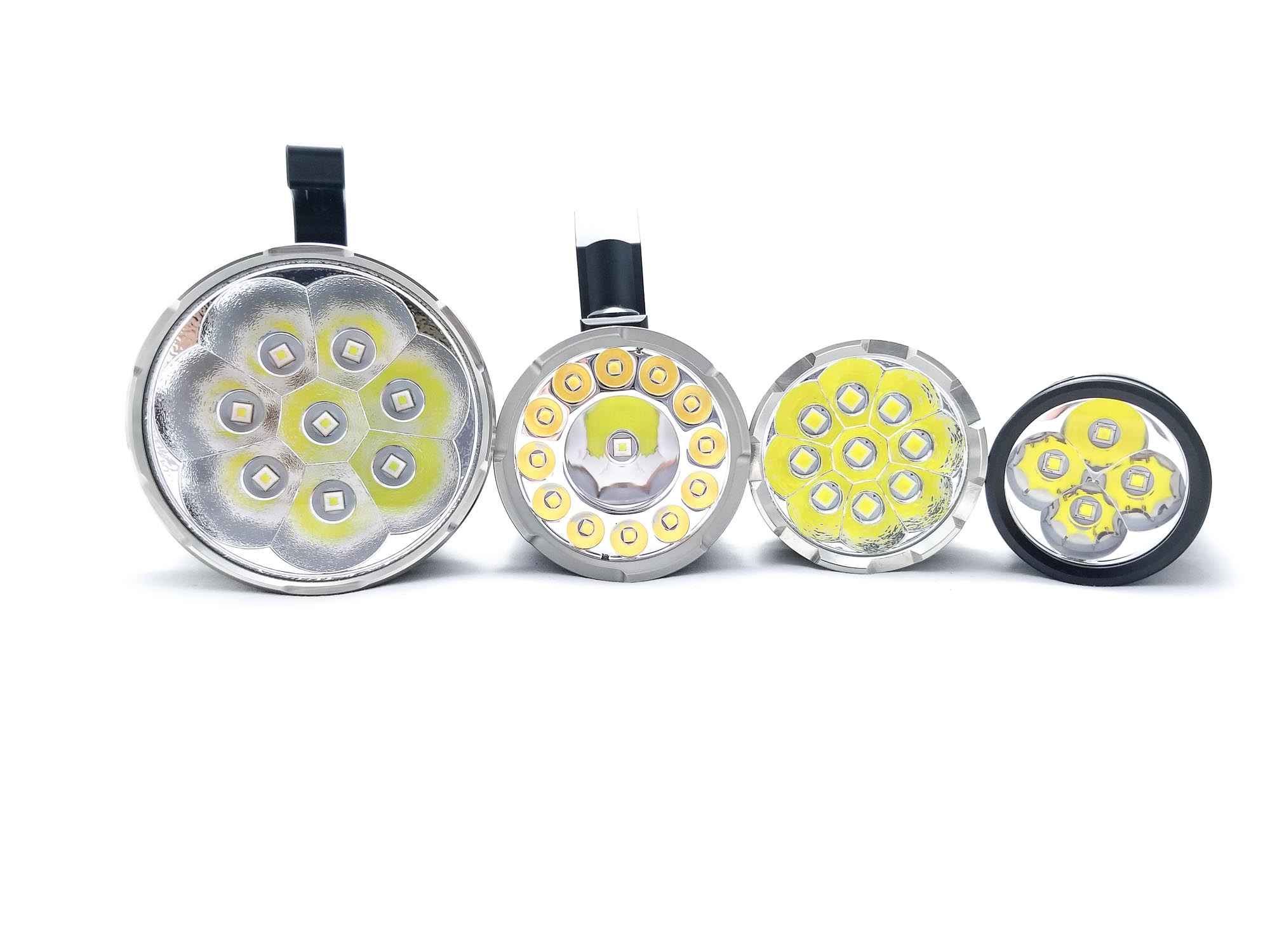
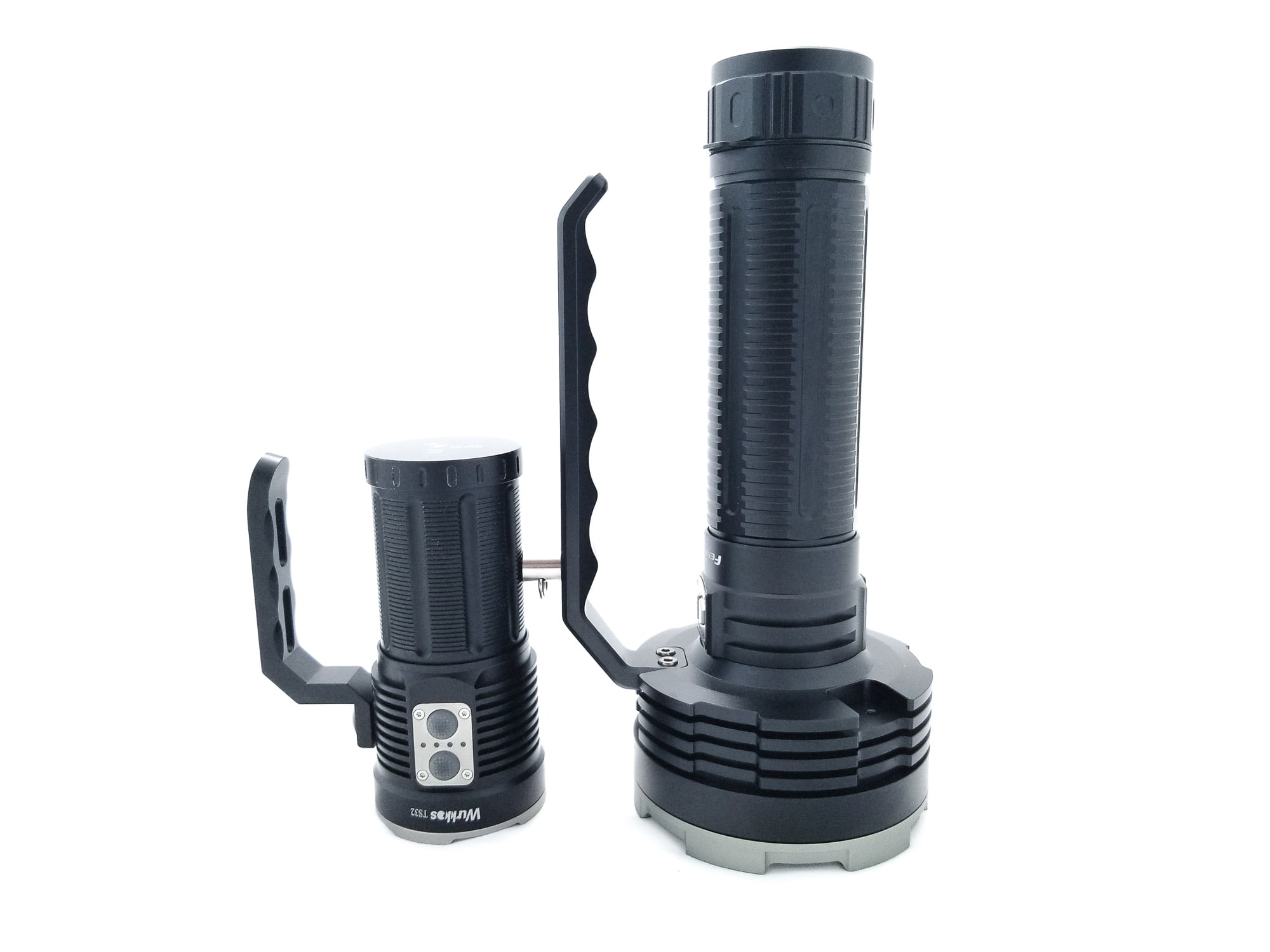
Driver & User Interface:
Wurkkos says the driver is a 2 channel affair, a combination of linear FET for the flood LEDs and a constant current buck driver for the center throw LED channel. It’s nice to see this combination on a budget light since it would have been easy (and cheap) for them to do a pure FET setup for both functions.
The UI for the dual switch setup is a good one, and I think it’s properly implemented. Despite cries from the masses for Anduril 2, Wurkkos went simple with a traditional, easy to use e-switch UI with stepped and smooth ramping for each function. Both switches operate each function independently, or they both can operate simultaneously. The front switch controls the spotlight (SFT-40-W) and the rear switch controls the floodlight (the 519As). It’s about as easy as it gets and it works awesome.
Available modes: Moonlight (flood only), Eco, Low, Medium, High, Turbo with smooth and stepped ramping
Available blinky modes: Strobe, SOS, Beacon
User interface:
From OFF:
- Press and hold in stepped and smooth ramping modes: Pressing and holding for 3 seconds activates Moonlight for flood and Eco for spotlight
- Single click: Turns on in last mode
- Double click: Turbo
- 3 clicks: Strobe
- 4 clicks: Electronic lockout
From ON:
- Press and hold in stepped ramping mode: Switches between brightness levels
- Press and hold in smooth ramping mode: Increases brightness. Release then click and hold to ramp down
- Single click: Turns off
- Double click: Turbo
- 3 clicks: Strobe
- 4 clicks: Switches between smooth and stepped ramping
Mode memory:
- Yes, last mode memory. Turbo and blinkies are not memorized
Shortcuts:
- Switch to smooth ramping: 4 fast clicks from on
- To Turbo: Double click
- To Blinkies: Triple click
Low voltage warning:
- There are 4 blue LEDs between the two switches that show battery state for both charging and bidirectional (power bank) functionality. In either function, LVP is set to 2.7 volts.
- For charging: 4 lights 100%, 3 solid lights, 1 flashling >75%, 2 solid lights, 1 flashing 75% to 50%, 1 solid, 1 flashing 50-25%, 1 light blinking <25%
- For discharging (power bank): 4 lights >75%, 3 lights 75% to 50%, 2 lights 50% to 25%, 1 light 25% to 3%, 1 light flashing 3% to 0%
Strobe/blinkies
- Strobe, SOS, Beacon. Triple click access the blinkie modes (starts in Strobe). To switch between SOS and Beacon, double click for SOS, double click again for Beacon. Only the flood LEDs are activated for Strobe, SOS, or Beacon
Lock-out mode:
- Yes. Accessed from off with 4 fast clicks. The flood LEDs will blink twice in Eco mode to acknowledge and blink twice in Eco mode when locked if the switch (either) is pressed. Repeat to unlock.
PWM
- Yes, but fast PWM and not visible by eye.
Additional info on the UI:
- This is a very busy UI, but I give Wurkkos a lot of credit for keeping it as simple as possible. In fact, it’s one of the better dual switch UIs I’ve come across in a light. I even like it more than the one on the $450 Fenix LR80R. Want the spotlight? Turn it on. Want the floodlight? Click it on. Want both? You can have that too. How about Turbo for both? Yep. It’s like Burger King: you can have it your way.
- At the end of the day, it’s a one click on, one click off with stepped or smooth ramping. The smooth ramping is pretty good, better than some I’ve used. The ramp speed is a bit slow on the spotlight, but seems faster on the flood mode. There’s a single blink at the top of the ramp, which I really like as well. The mode spacing is also reasonable, although Turbo for the flood LEDs is a huge jump from High. The only quirk is the floodlight has a moon mode and the spotlight doesn’t, and has to make do with Eco. The moon for the flood is pretty low, but not sub lumen, which is a good thing and I think adds to the usefulness of the light. Wurkkos says there’s auto thermal control set to 55 C, so we’ll see how that goes. Wurkkos/Sofirns thermal regulation tends to take runtimes on a sawtooth rollercoaster ride.
Batteries & Charging
The TS32 has followed the popular kids on the block and gone with a 3×21700 battery configuration. The three cells are arranged in parallel for 4.2 volts and up to 15,000 mAh if outfitted with 5000 mA cells. The batteries are removable, and just about any unprotected 21700 will fit. Although it’s designed for button tops, thanks to the included adapter, your flattops won’t feel left out and they can play with the TS32 as well.
The light came with 3 Wurkkos branded 5000 mAh flat top 21700s. These are probably made by Lishen or Hi Long Battery Corp. and are pretty decent cells. They’re coming in around 15 milliohms in my Vapcell S4+, so similar to a Samsung 50G. When I recharged them after a runtime test, I was getting about 4600-4700 mAh from 2.9 volts.
I tried some Molicel P42As and they were fine, but longer cells were a bit too tight. There’s onboard charging as well, handled through a USB type C port under the rubber cover. It’s set to 5V 3A (15 watts max), and worked with a type C to C cable as well as a USB to type C. There’s also bidirectional charging so the TS32 can function like a power bank. However, you need a type C to type C cable for that to work (sadly, not included). It’s also set for up to 5V 3A. The Ruideng AT35 USB tester showed around 5 volts 1.5 amps on USB A to type C, and USB C tester showed about 4.9 volts 2.9 amps on type C to C for charging. I plugged the Amutorch DM80 into the TS32 power bank and it charged it at the DM80’s max charge rate 5 volts 2 amps. I plugged the TS32 into it’s half-sibling Sofirn SP36 Pro and it started charging at 5 volts 3 amps. While 15 watts is nice, I think this light could really benefit from 12v 1.5A charging, especially with almost 15 Ah on board.
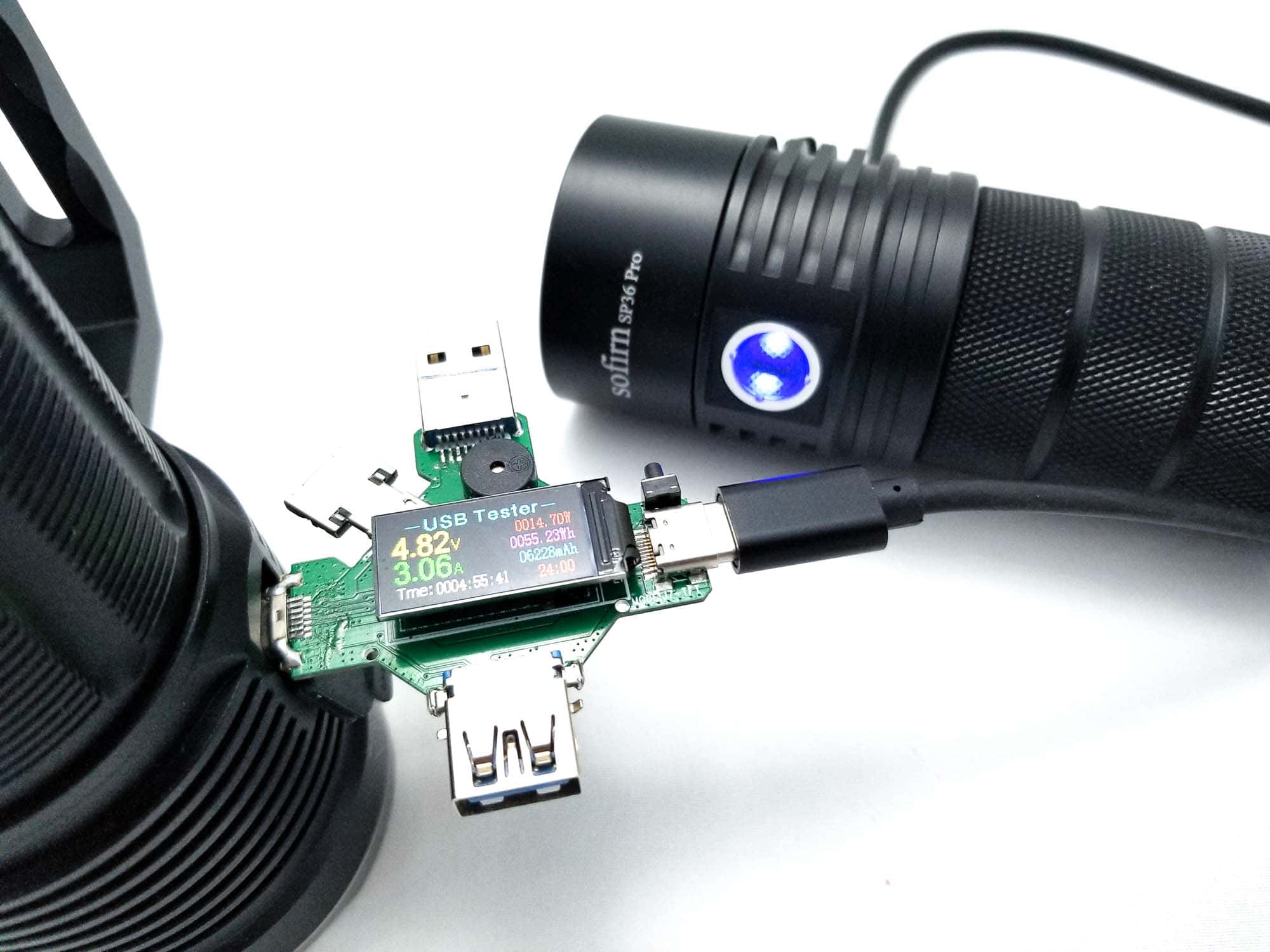
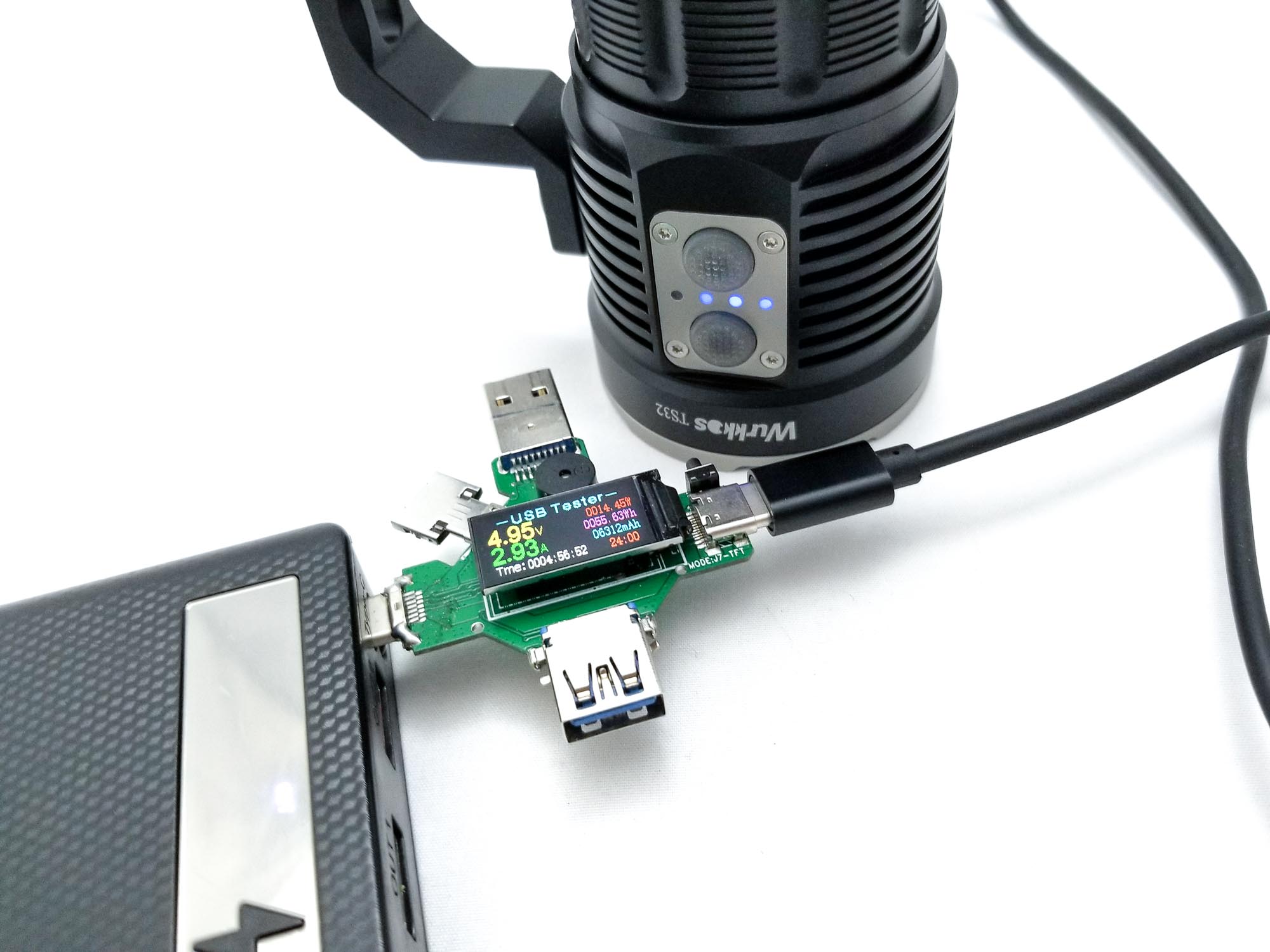
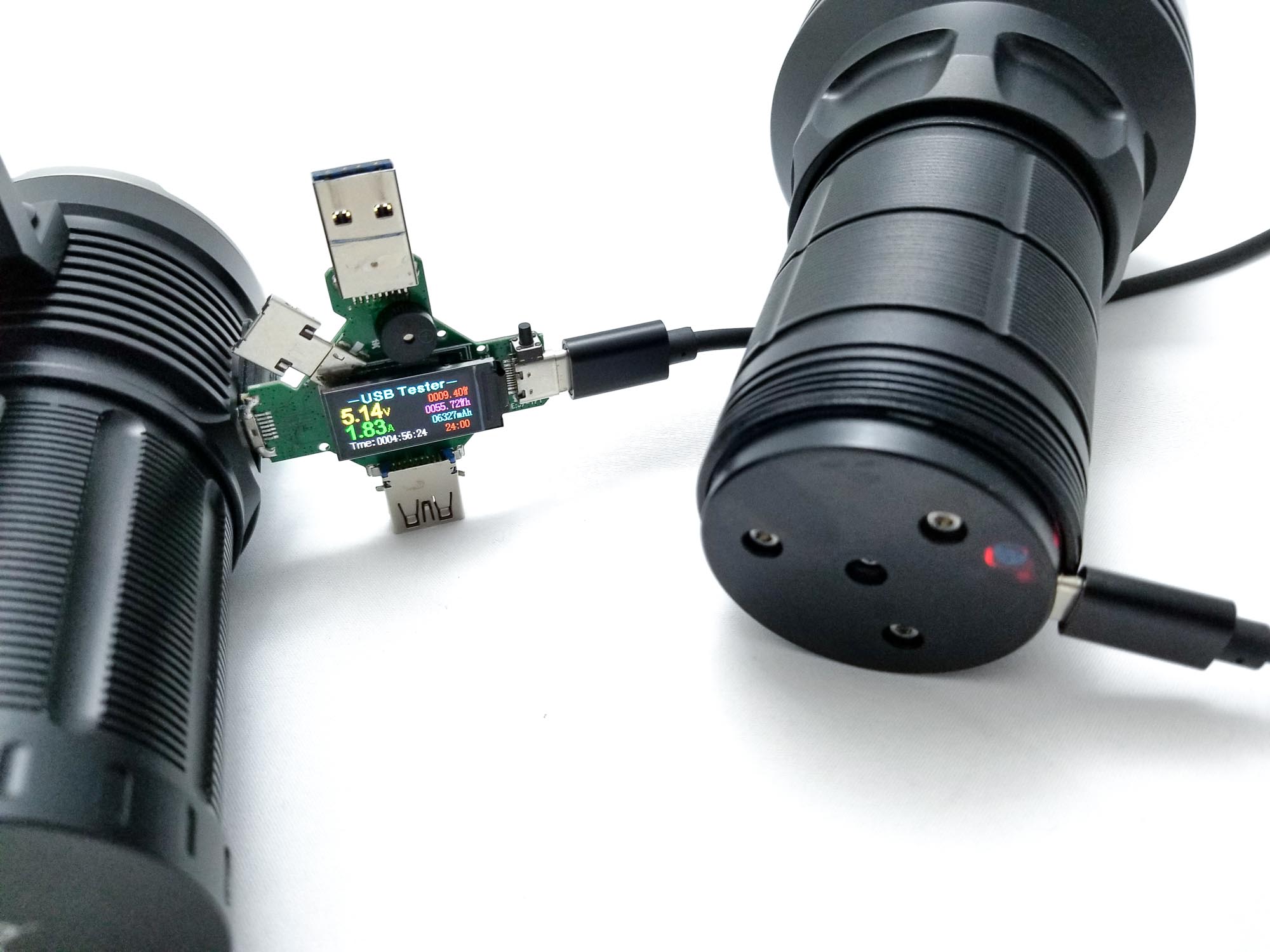
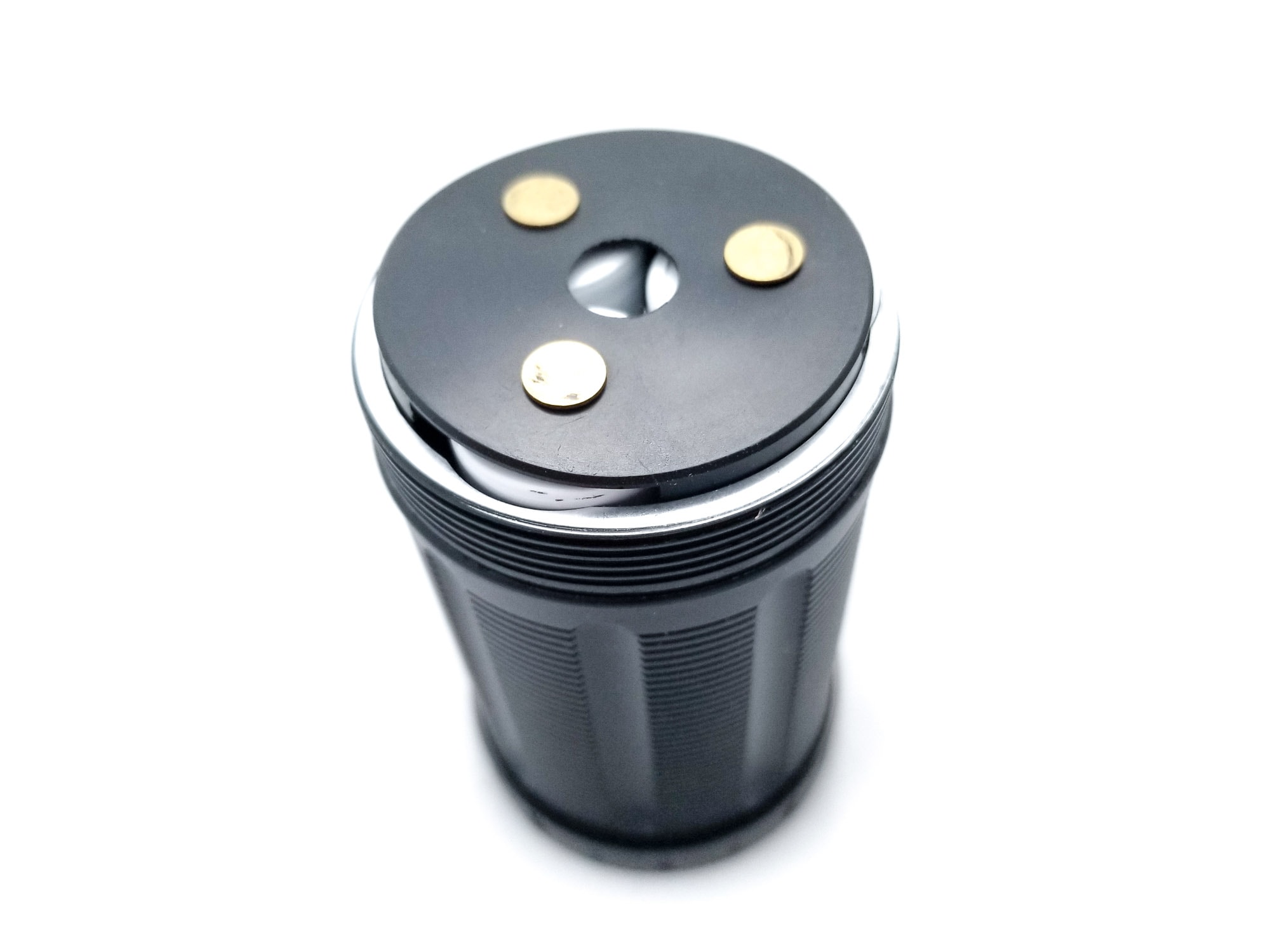
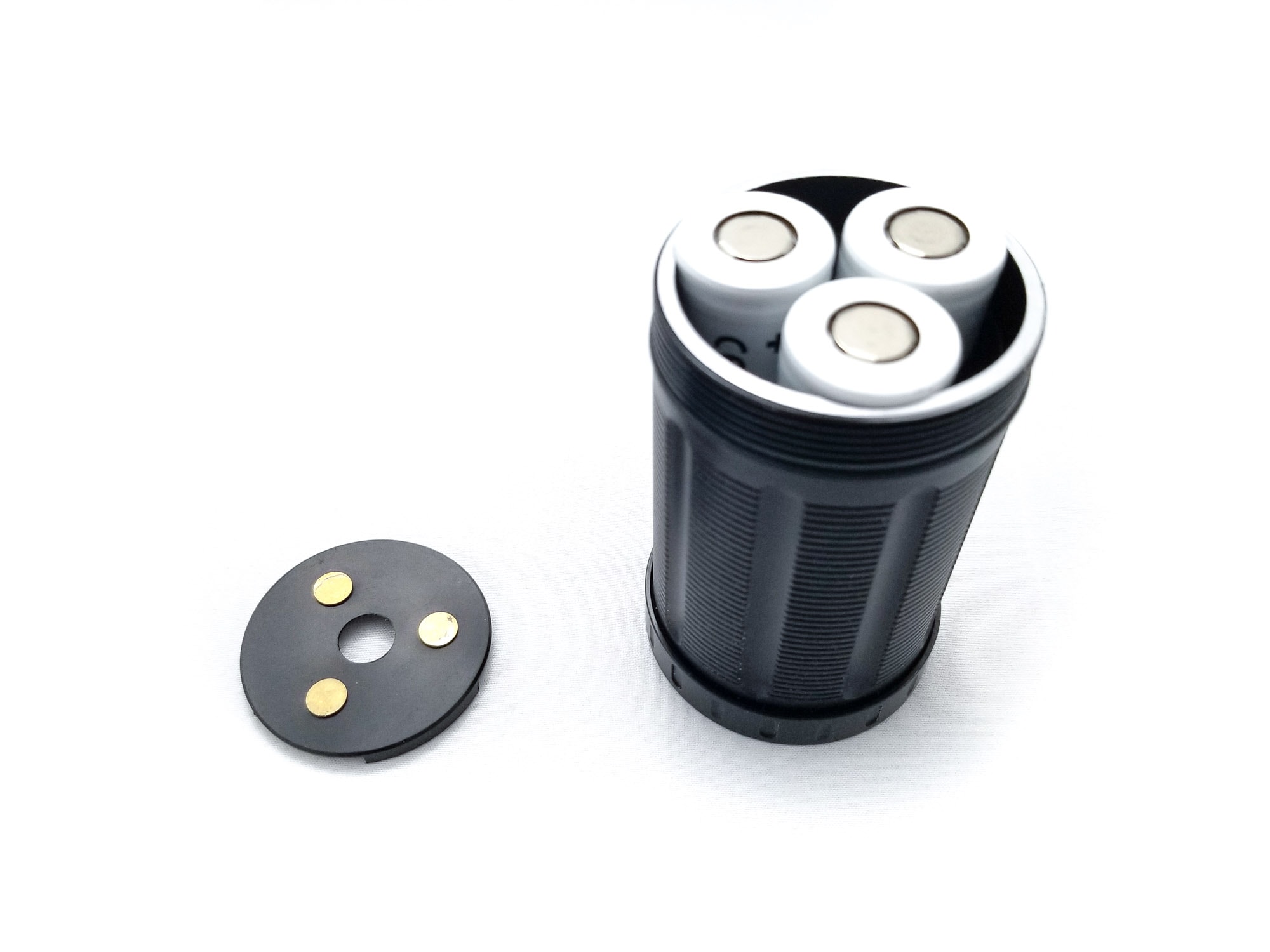
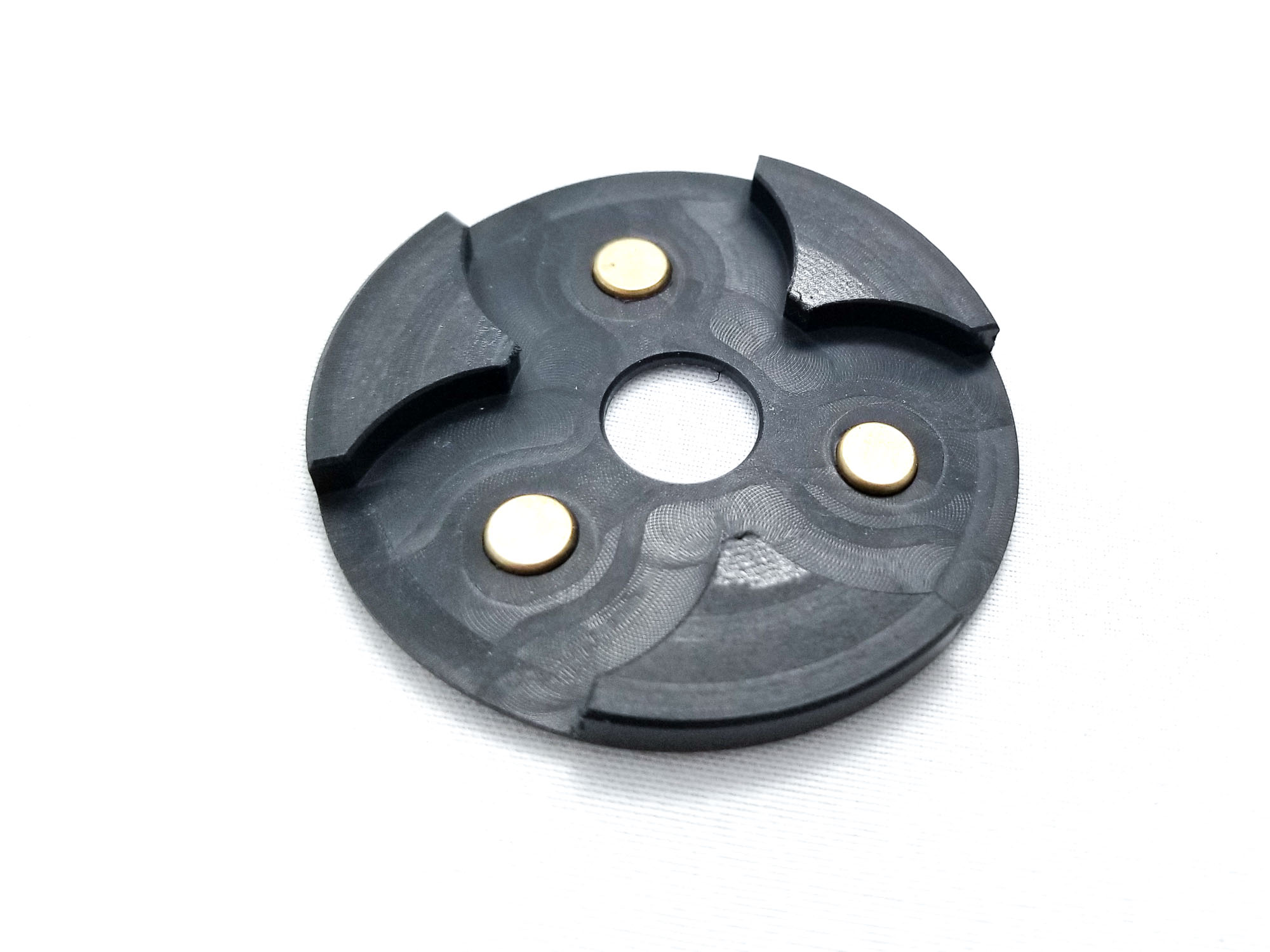
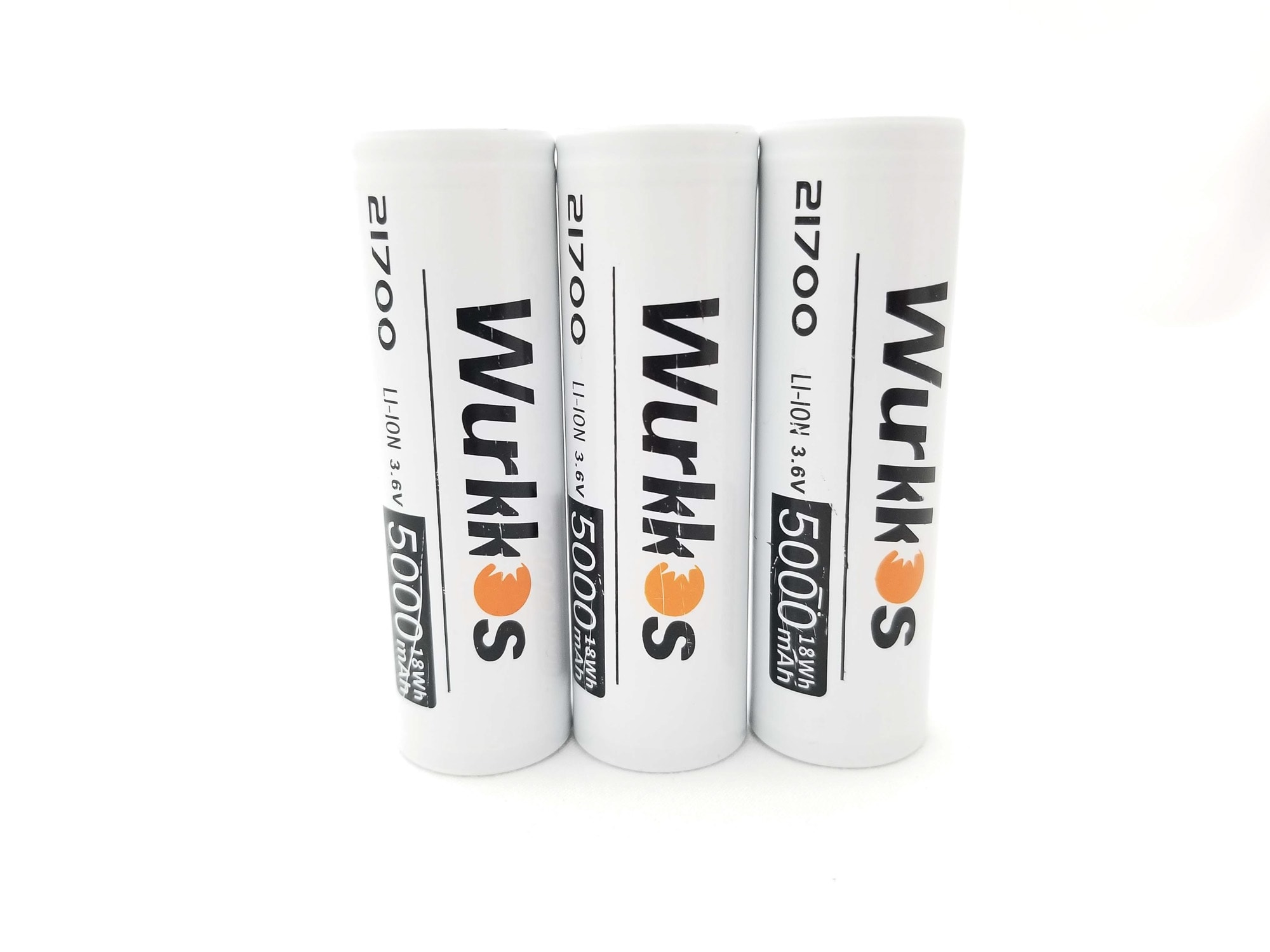
Performance test
Lumen measurements
Lumens are measured using my home made 50 cm integrating sphere, and I use a Digi-Sense 20250-00 datalogging luxmeter. The sphere has been calibrated using a Convoy S2+ calibrated to 260 Lumens, so these are within 10% of actual output. All measurements were taken at 30 seconds using the included fully charged 5000 mAh batteries. No amp measurements this time. You need to be a gymnast (and brave) to measure current with these lights.
| Mode (flood) | Specs | turn on | 30 sec | 10 minutes |
|---|---|---|---|---|
| Moonlight | 5 | 9.7 lm | 9.7 lm | – |
| Eco | 50 | 44 lm | 44 lm | – |
| Low | 400 | 311 lm | 311 lm | – |
| Mid | 1200 | 873 lm | 861 lm | 836 lm |
| High | 3600 | 2768 lm | 2694 lm | 1267 lm |
| Turbo | 12,000 | 12,546 lm | 11,439 lm | 1353 lm |
| Mode (spot) | Specs | @turn on | @30 sec | @10 minutes |
| Eco | 10 | 9.7 lm | 9.7 lm | – |
| Low | 100 | 103 lm | 103 lm | – |
| Mid | 350 | 332 lm | 320 lm | 320 lm |
| High | 900 | 824 lm | 787 lm | 775 lm |
| Turbo | 2000 | 1624 lm | 1599 lm | 1525 lm |
| Mode (flood+Spot) | Specs | @turn on | @30 sec | @10 minutes |
| Turbo | 13,000 | 13,776 | 12,300 lm | 1476 |
Parasitic drain:
- N/A
Wurkkos doesn’t list output specs for flood+spot besides Turbo, and I only tested that mode. My figures are generally in the ballpark, and within my 10% of actual spec. The flood mode has a Moonlight, but spot mode doesn’t. Interestingly, you can’t use Moonlight or Eco mode for each mode simultaneously; it’s one or the other.
Battery Life: Runtime graphs
Oh boy, lots of runtimes!
Runtimes are measured using my home made 50 cm integrating sphere, and I use a Digi-Sense 20250-00 datalogging luxmeter. The sphere is calibrated using a Convoy S2+ calibrated to 260 Lumens. I used the included, fully charged, 5000 mAh batteries. Wurkkos doesn’t list any runtime specs for the combined function.
Flood runtimes:

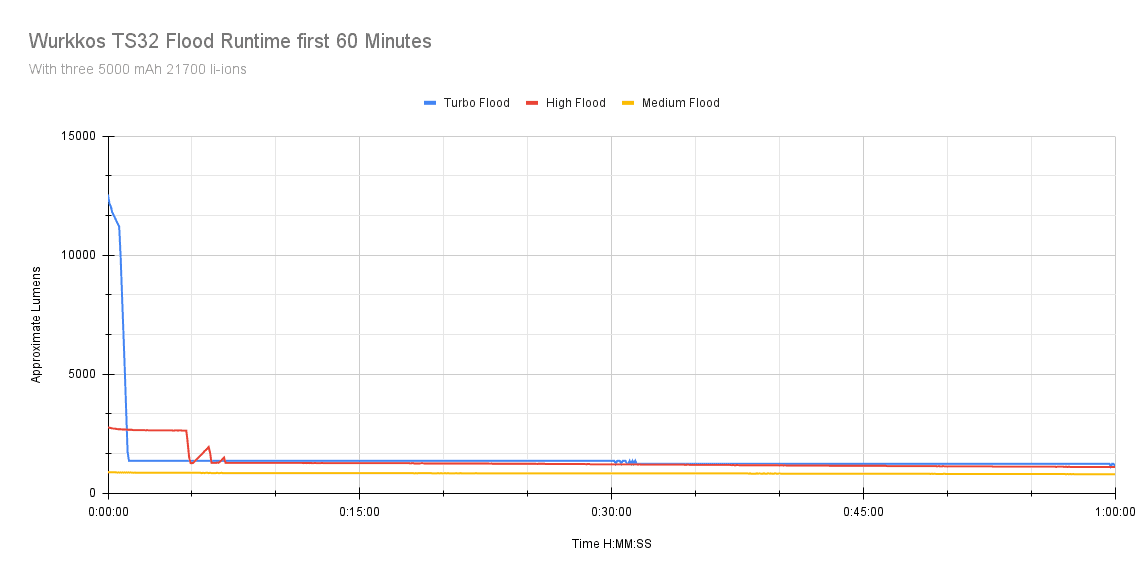
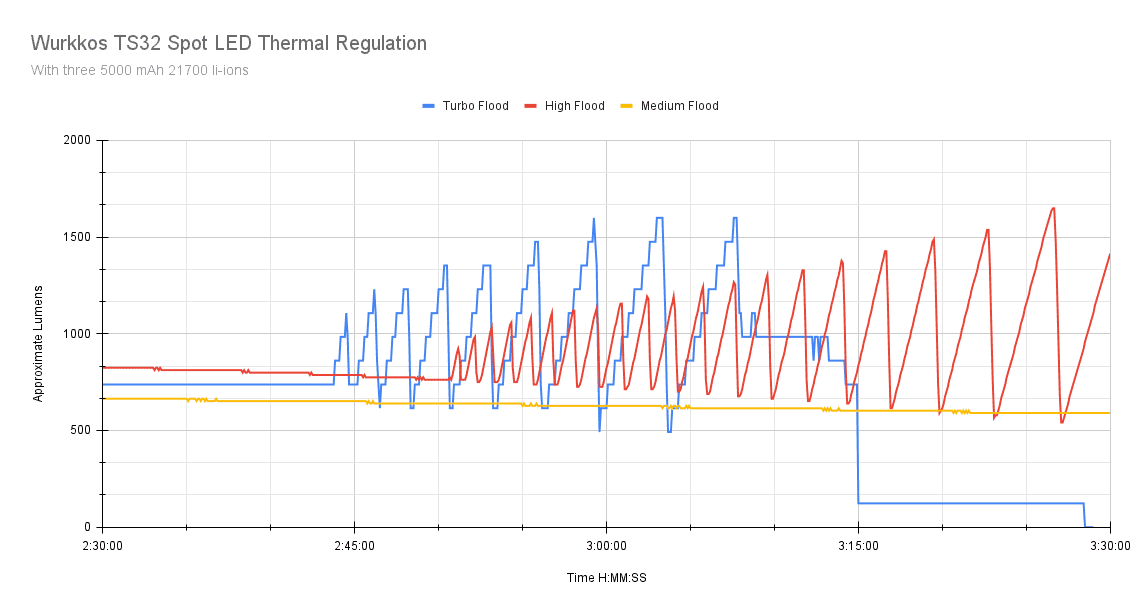
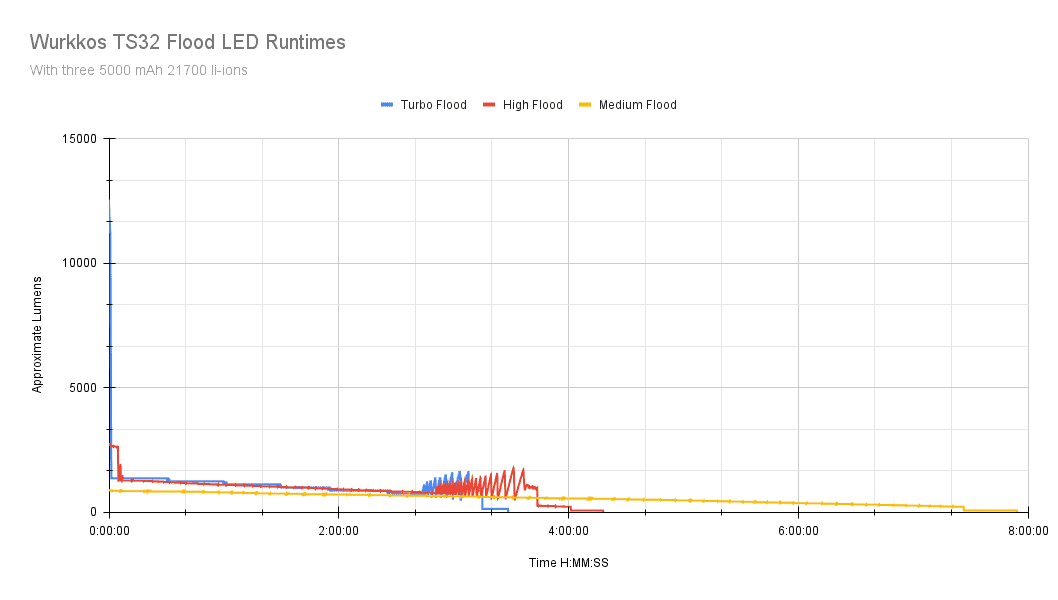
| Mode (flood) | Specified | Measured runtime (ANSI) | Time till shut off |
|---|---|---|---|
| Medium | 5h | 7h 26min | 7h 54m+ |
| High | 2h 30min | 3h 43min | 4h 18m+ |
| Turbo* | 1h 20min | 1h 01min | 3h 25m+ |
And Spot runtime graphs
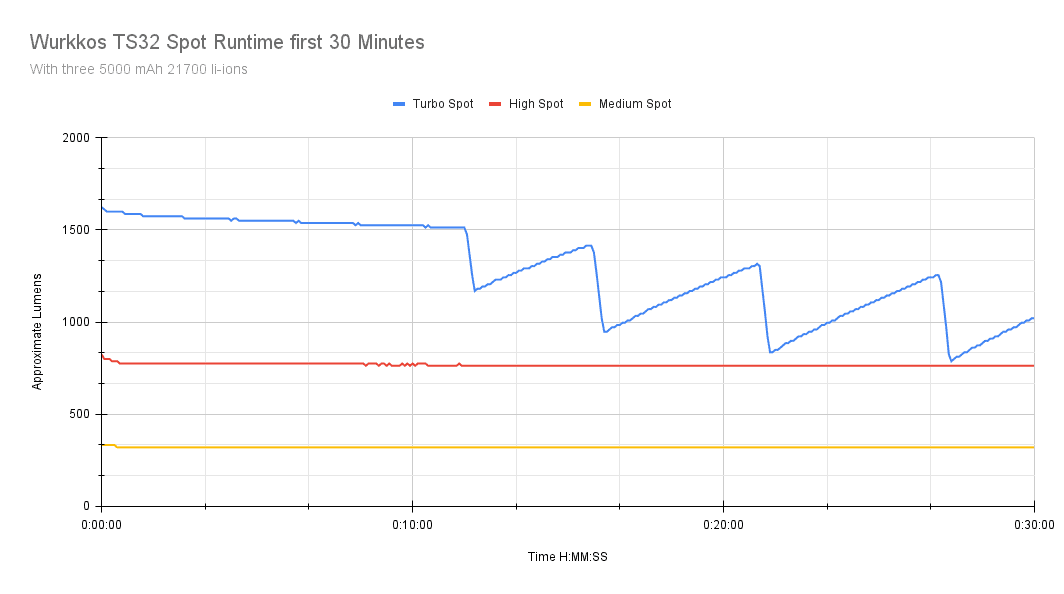
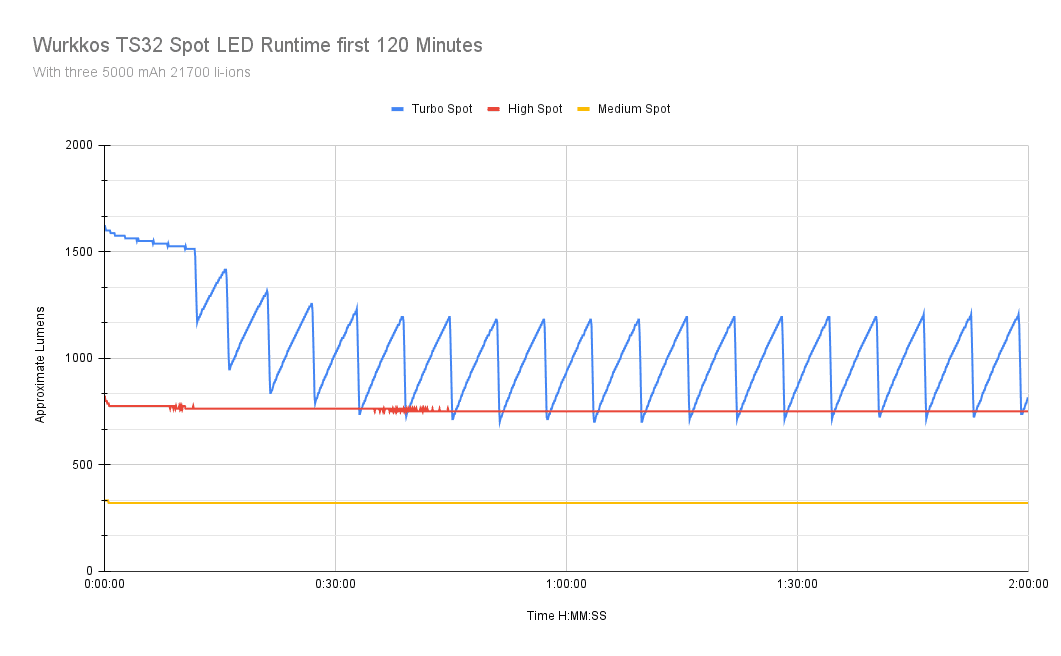

| Mode (spot) | Specified | Measured runtime (ANSI) | Time till shut off |
|---|---|---|---|
| Medium | 25h 10min | 23h+ | 23h+ |
| High | 6h 30min | 9h | 12h 3min |
| Turbo | 4h 30min | 6h 05min | 10h 16min |
And flood + spot runtime
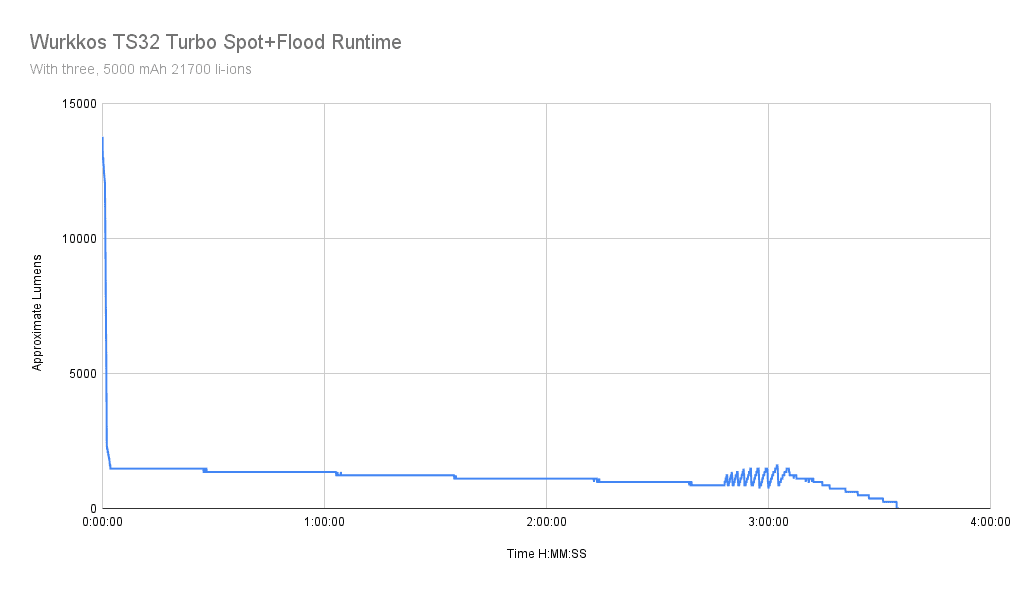
| Mode (flood+spot) | Specified | Measured runtime (ANSI) | Time till shut off |
|---|---|---|---|
| Turbo | ? | 1h 03min | 3h 34min |
Flood Turbo and Spot+Turbo stepped down very fast (and heated up fast) as expected to under 2000 Lumens within 60 seconds. Still not bad, and the sustained output isn’t terrible, about 1000 Lumens. The thermals are kept under control as well, with the head never cresting 63 C, and thanks to the handle, it’s bare-handable for extended periods.
The runtimes are all over the place, and that’s expected since the spot LED runs off a buck driver and the flood LEDs run off an unregulated FET driver. The flood LED modes stepped down to a very low output after LVP hit, and I ended the tests before it actually shut off (like with Anduril/Anduril 2 lights). The spot LED Medium mode ran, and ran, and ran. I ended up stopping the test after almost 24 hours because it hadn’t even stepped below 35 Lumens yet. I have no doubt it would have finished out the 25h+ runtime spec. The higher output runtimes all have thermo regulation with the familiar Wurkkos/Sofirn sawtooth pattern. Interestingly, the regulation starts well into the tests for both High and Turbo modes. I’m used to seeing this behavior shortly after turn-on. This time it’s not as bad as previous iterations, so it’s clear the algorithms have been tweaked a bit, but it is still slightly noticeable if you’re paying attention. I took a section of the runtimes after about the 2 hour 30-minute mark to show the regulation.
ANSI FL1 standards: The runtime is measured until the light drops to 10% of its initial output (30 seconds after turning on). This does not mean that the flashlight is not usable anymore. The last column shows how long the light actually works till it shuts off. If there is a + symbol, it means that the test was stopped at that particular point, but the light was actually still running. This happens on certain occasions, with certain drivers, firmware, or batteries.
Wurkkos TS32 peak beam intensity and beam distance measurements
Throw was measured indoors at 5 meters using the Uni-T UT383S luxmeter. Measurements taken at 30 seconds. Lots of modes means lots of results!
| Mode (Flood) | Specs | Candela measured | Meters | Yards |
|---|---|---|---|---|
| Moon | ? | N/A | – | – |
| Eco | 90 | 325 | 36 | 39.4 |
| Low | 600 | 800 | 57 | 62 |
| Medium | 2087 | 2,575 | 101 | 111 |
| High | 5350 | 7,825 | 177 | 194 |
| Turbo | 38,787 | 15,075 (38,375 at start) | 246 (392 at start) | 269 (428 at start) |
| Mode (spot) | Specs | Candela measured | Meters | Yards |
| Eco | 672 | 675 | 51.9 | 56.7 |
| Low | 5058 | 5,350 | 146 | 160 |
| Mid | 17,266 | 19,375 | 278 | 305 |
| High | 42,083 | 45,700 | 428 | 468 |
| Turbo | 85,416 | 92,250 cd | 607 | 664 |
| Mode (flood+Spot) | Specs | Candela measured | Meters | Yards |
| Turbo | ? | 93,825 cd | 613 | 670 |
Wurkkos doesn’t list candela specs for the flood+spotlight, but I measured them for yucks. They do list a ‘combined’ throw figure of 637 meters. I got 612.6 for that figure (throw+flood LEDs both on Turbo). Moonlight mode is too low to measure at 5 meters.
Extra info: Peak beam distance according to ANSI FL1 standards: The calculated value of distance in meters at which the flashlight produces a light intensity of 0.25 lux. (0.25 lux is about the brightness of a full moon shining on an object).
Beamshots
I compared the TS32 to some other high output multi-LED flashlights. Photos taken with my Samsung Note 8. The 95 meter shots with the following camera settings 0.3s ISO 200 and 5000K WB.
Beamshots compared to the following flashlights (at 40 meters):
- Wurkkos TS32 (flood, spot and combo)
- Haikelite HT90
- Fenix LR80R
- Nightwatch NS59v1
- Haikelite HK90
- Thrunite TN50
- Sofirn SP36 Pro Anduril 2
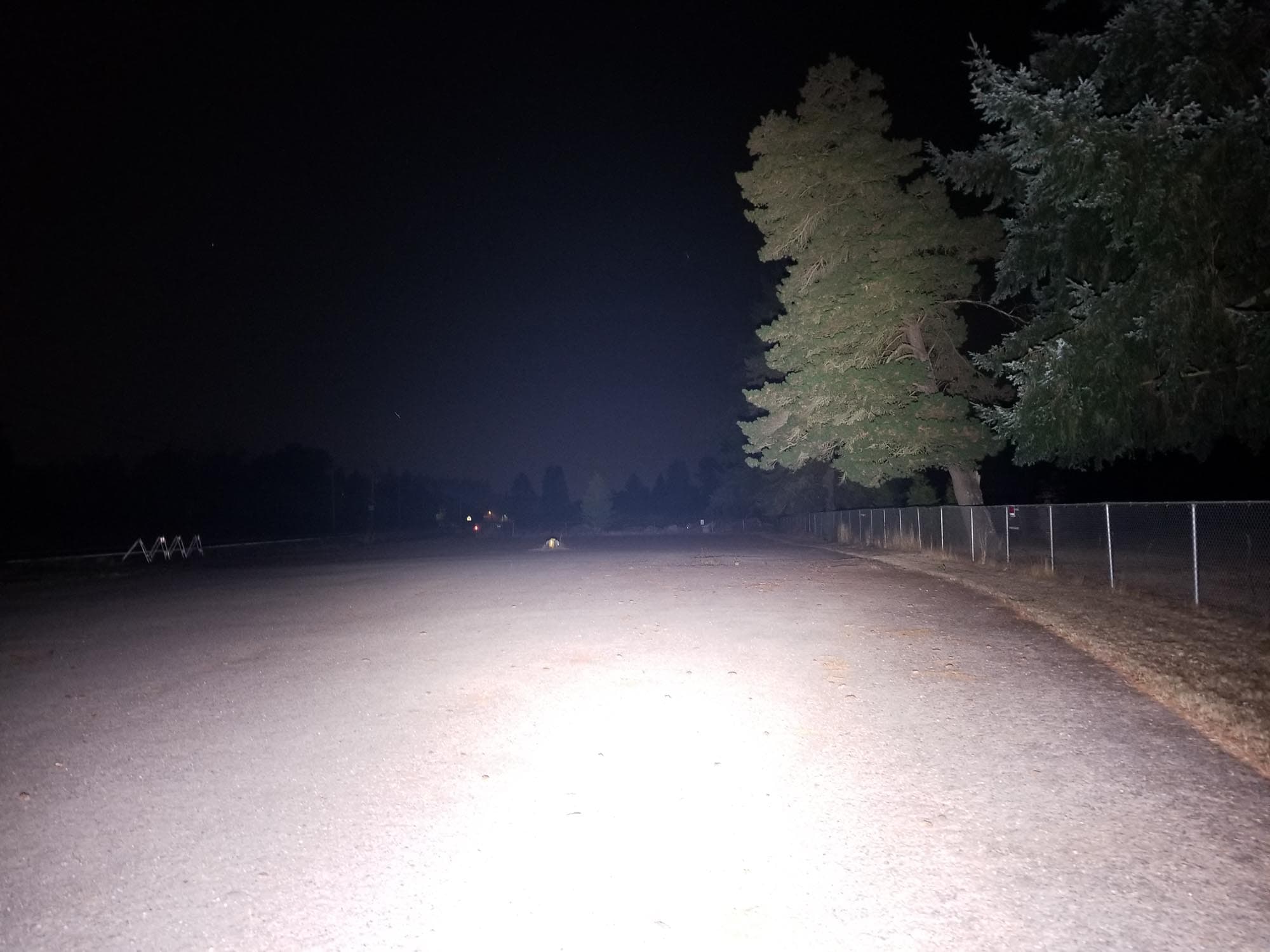
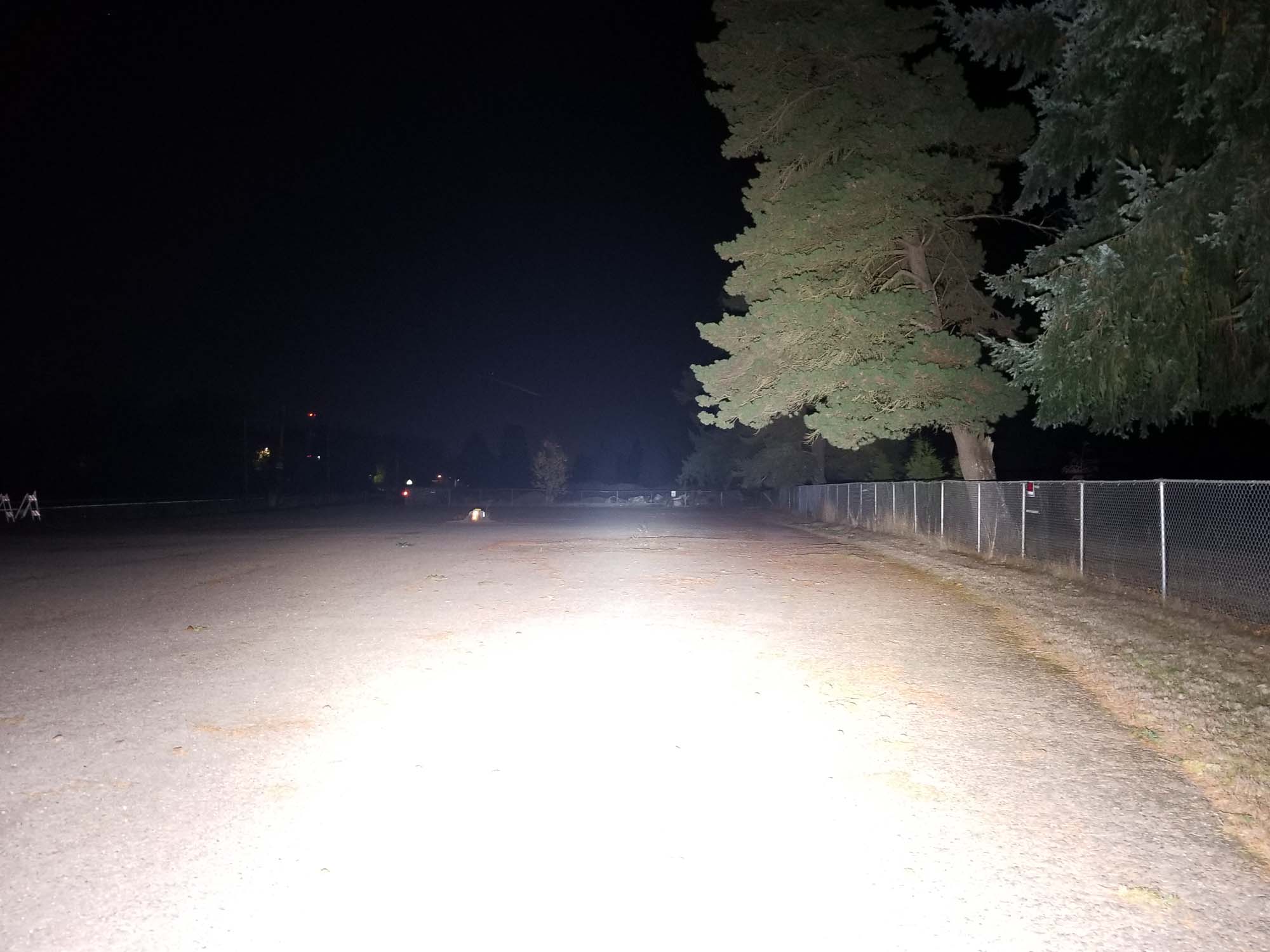
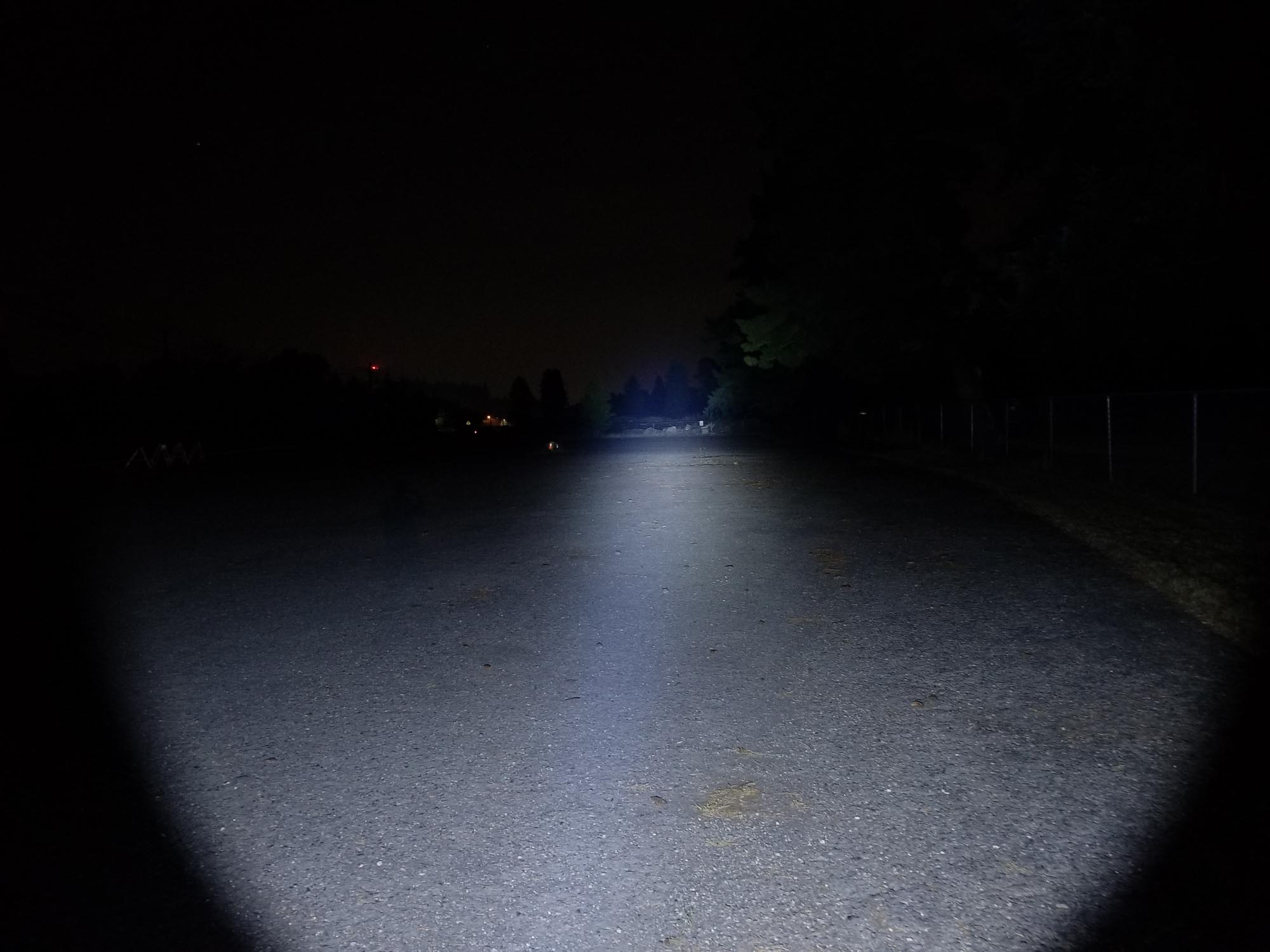
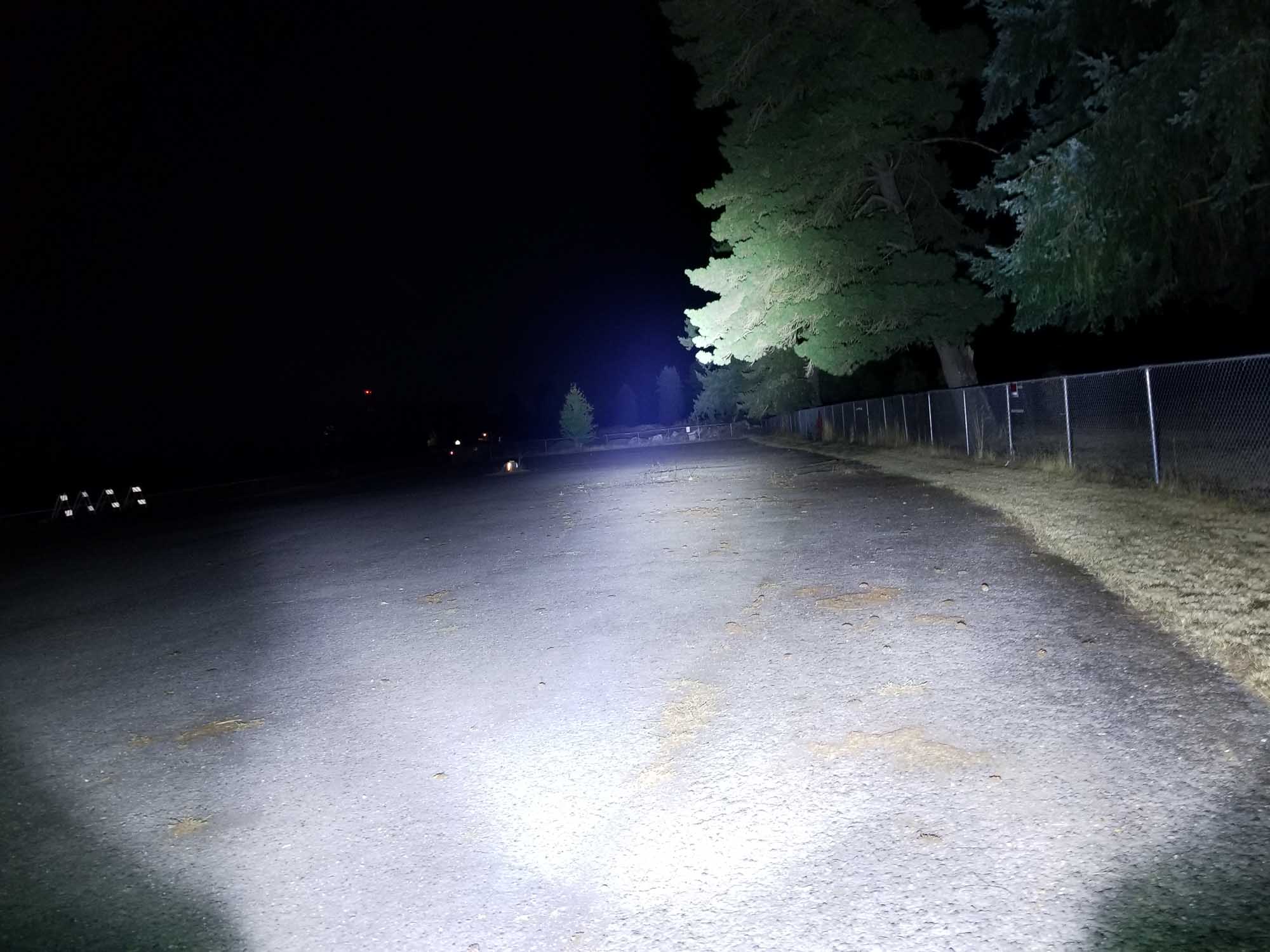
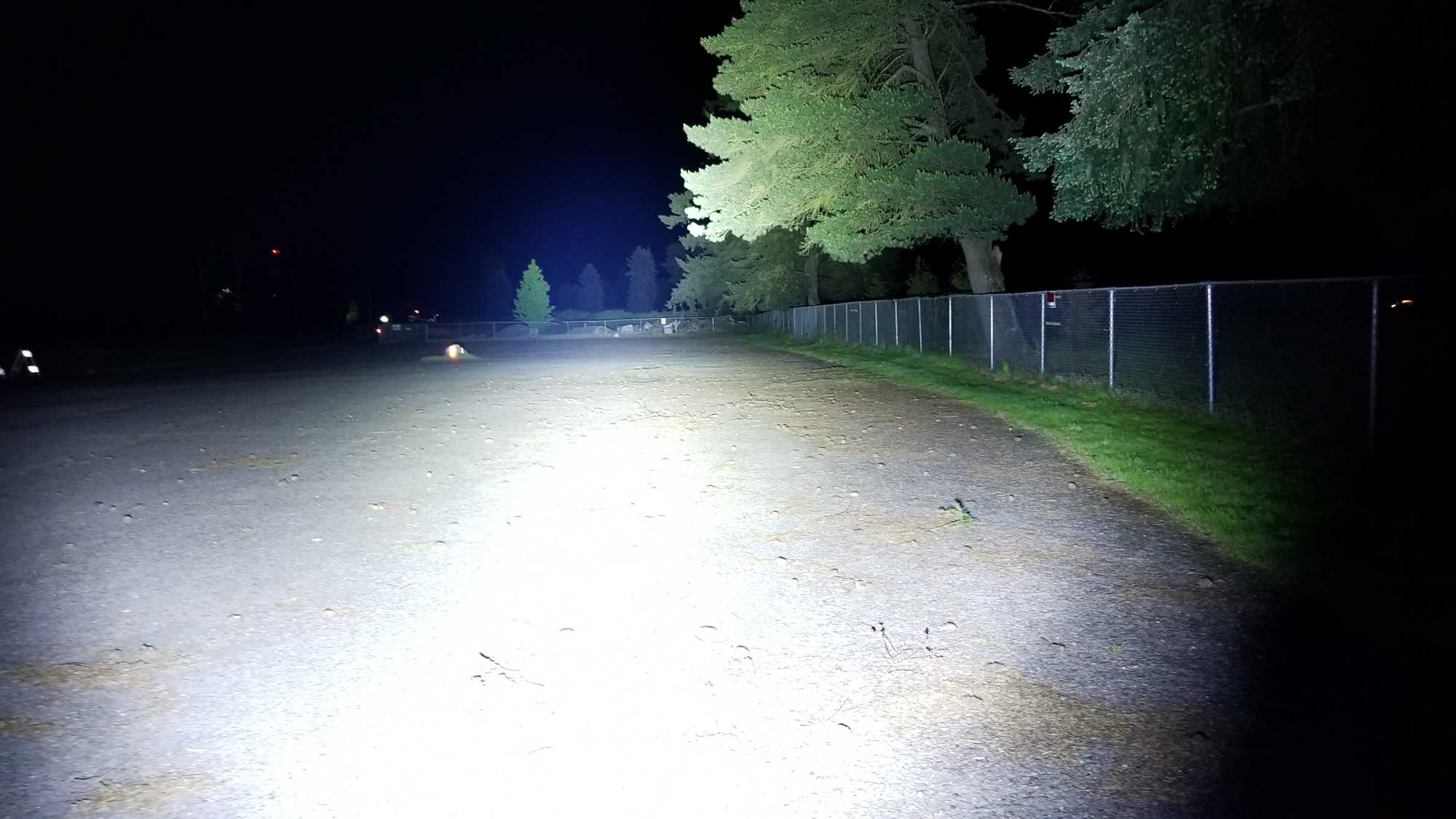

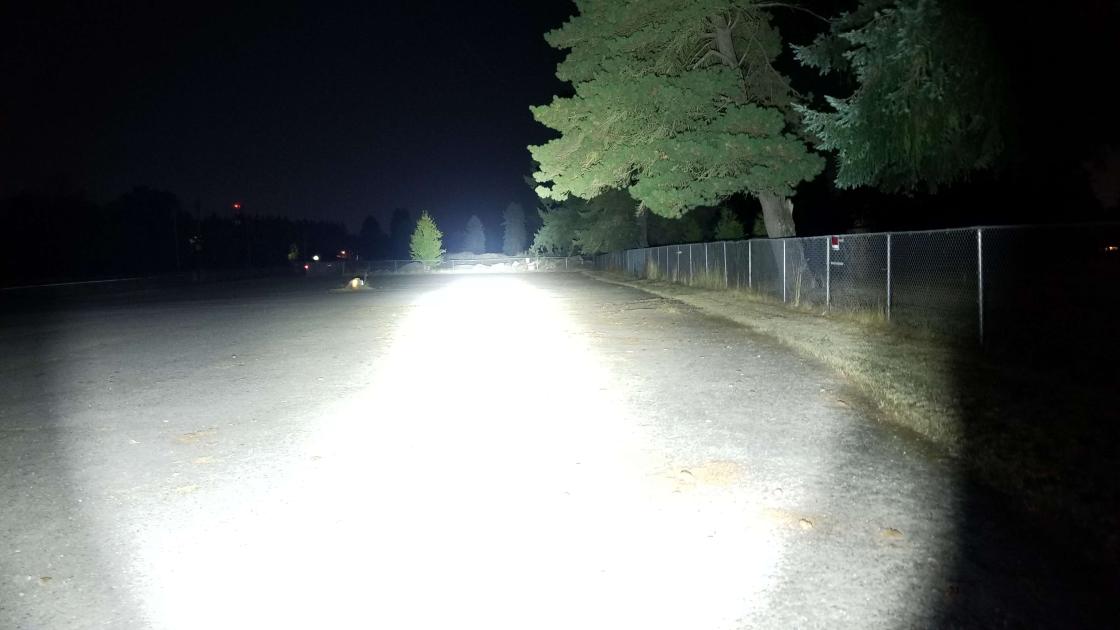
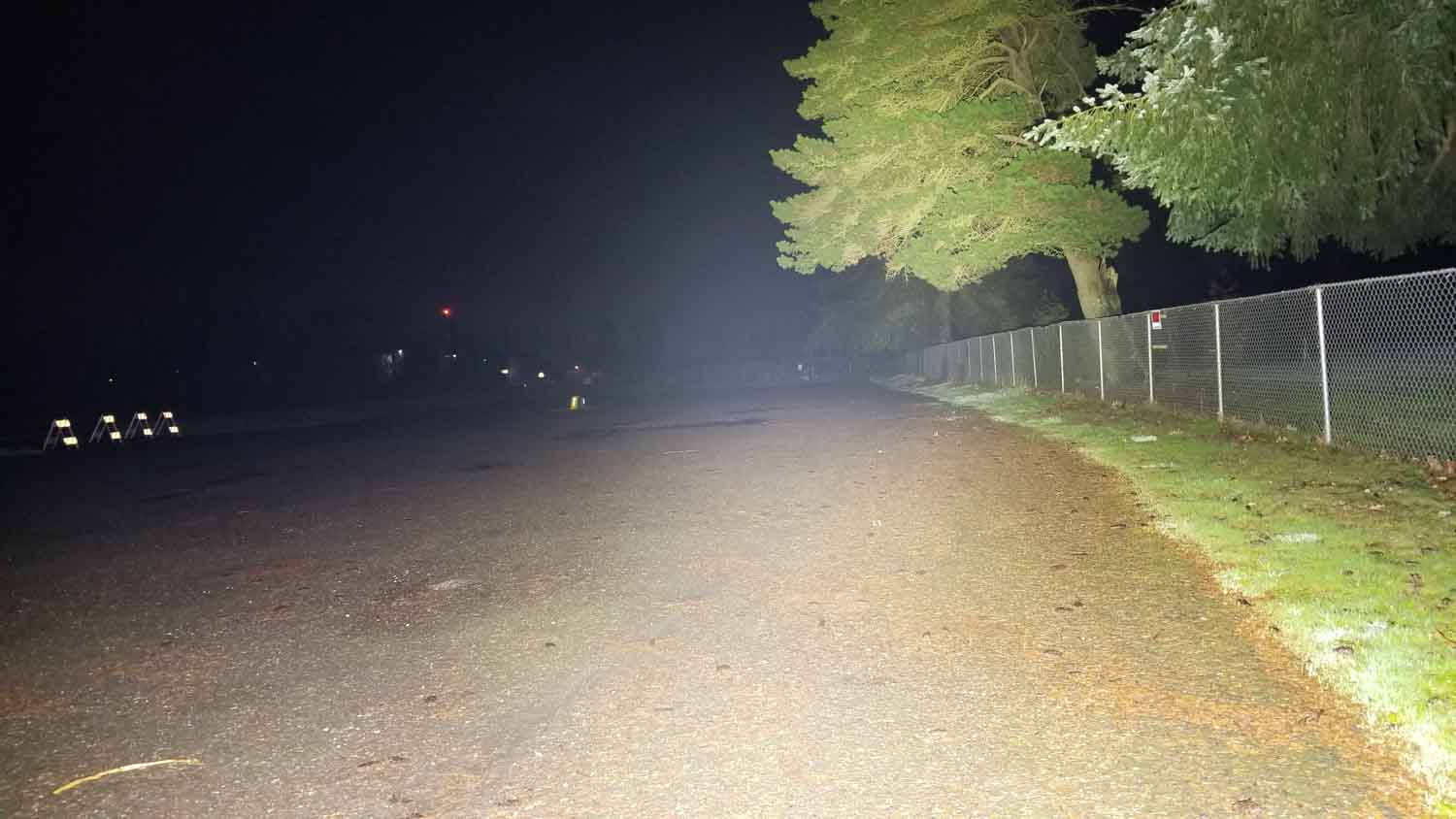
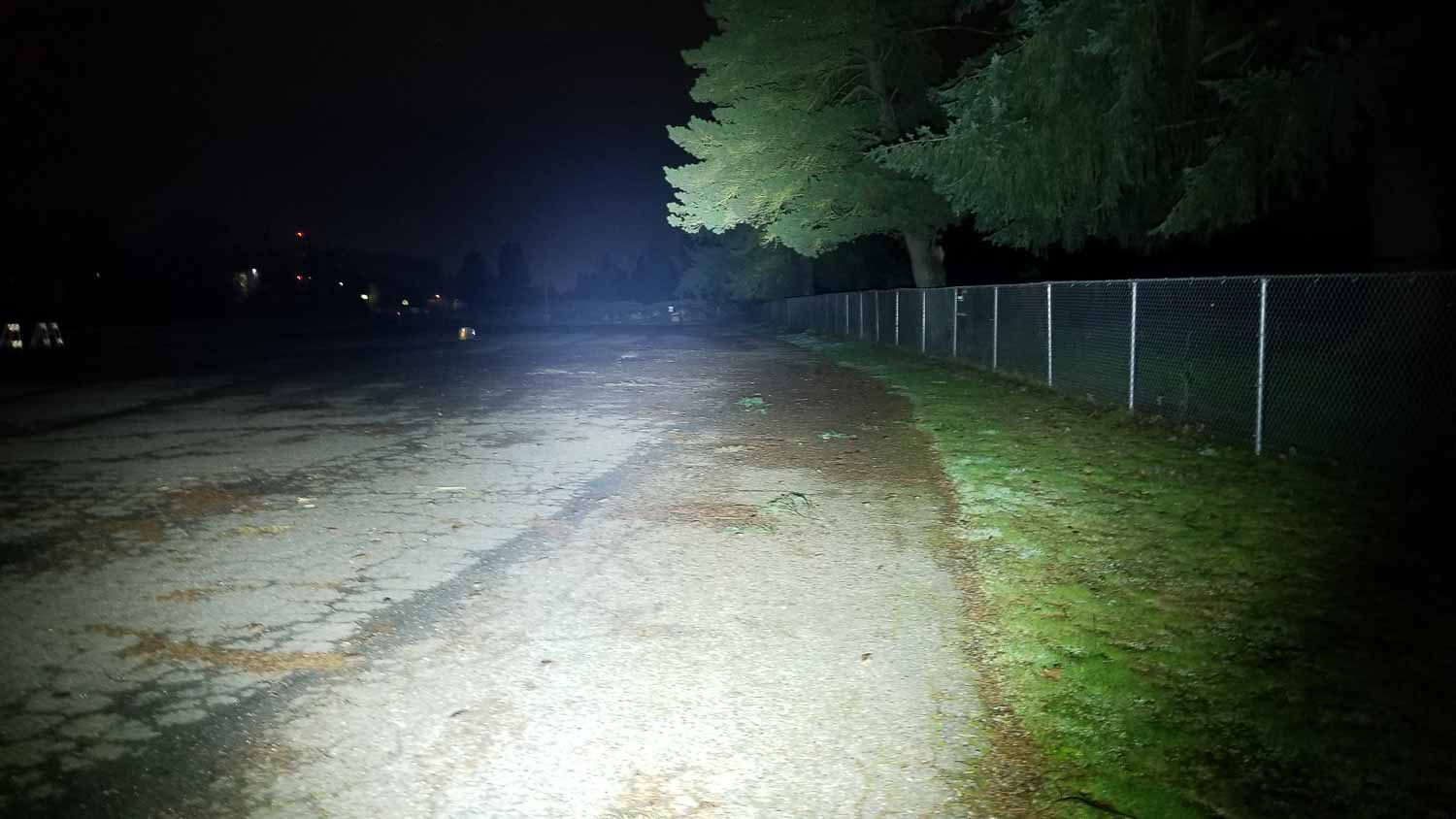
Disclaimer: This flashlight was sent to me for review at no cost by Wurkkos. I have not been paid to review, nor have I been holding back on problems or defects.
Final Verdict
Pros
- Great performance
- Very affordable
- Integrated quick charging and power bank
- Effective and easy to use dual switch UI
- Decent smooth and stepped ramping
- Can use flat top or button top cells
- Improved thermal regulation
Cons
- Shoddy build quality issues with misaligned flood LEDs
- Could benefit from 12v 1.5A charging
- Handle has a tendency to come loose unless really tightened down
Explanation on star ratings:
1: Avoid: a match would be a better choice – 2: Poor: significant defect or issues; almost unusable – 3: Average: some defects or issues; but still usable 4: Good: recommended (minor issues) – 5: Great: highly recommended

4 stars: ★★★★
I remember when Wurkkos was an obscure brand relegated to indentured servitude under Sofirn, making a few mundane and pretty ordinary lights here and there (as well as selling home goods and nick-nacks). Well, no more, and the recent releases of the new TS series, with this TS32 as the centerpiece, has added considerable street cred in the flashlight continuum.
After spending a few weeks with the TS32, it’s obvious they’ve fielded a heavy hitter and are swinging for the fences on a budget. Although my sample is a bit of a let-down with the shoddy quality control, the rest of the accouterments and features makes up (a bit) for that. I like the high output, beautiful Nichia 519A flood LEDs, and the SFT40-W was a great choice for the throw LED.
The beam is very versatile, and the addition of onboard charging with power bank adds a lot of usefulness. Stick on a diffuser, and the TS32 becomes a nice lantern. Wurkkos attention to the ‘little things’ like the flat top battery adapter really makes my day here, so big kudos to them for that. The UI, well it’s one of the better dual switch UIs I’ve come across lately and I appreciated the smooth/stepped ramping options. It’s an otherwise full-featured, highly versatile UI (and easy to use). Is the TS32 perfect? Far from it, but for what it is, I think they did a great job here. Tighten up the quality control, and this represents a fantastic bang-for-your-buck multipurpose light and a big step in the right direction for Wurkkos. The quality control holds it back from 5 stars, so 4 stars for the TS32.
Buy Wurkkos TS32 here:
1lumen selects and reviews products personally. We may earn affiliate commissions through our links, which help support our testing.